24 Top Rated Attractions in Mae Sariang (2025)
Discover Mae Sariang, a captivating sub-district nestled in Mae Hong Son Province, northern Thailand. Home to a population of nearly 10,000 friendly locals, this hidden gem is a gateway to the region’s enchanting beauty and vibrant culture. Mae Sariang boasts nine charming villages, where visitors can explore ethnic Karen and Lawa communities, picturesque hills, and the scenic Yuam River. Delve into the area’s rich history with visits to ancient temples such as Wat Phra That Chom Thong and Wat Phra Non, or embark on an adventure in the majestic Salawin National Park. With its unique local cuisine, wooden architecture, and warm hospitality, Mae Sariang invites travelers to experience the charm and tranquility of this lesser-known Thai treasure.
The Mae Sariang route stretches far into the southern mountains, with long sections lacking fuel or accommodation, making planning essential. Sunset views along the western ridges are stunning, but lodging should be confirmed before continuing on. Multi-day riders must also maintain their chain tension for safety. For comfort and reserve power on extended trips, arrange a motorbike rental from our fleet before leaving the city.
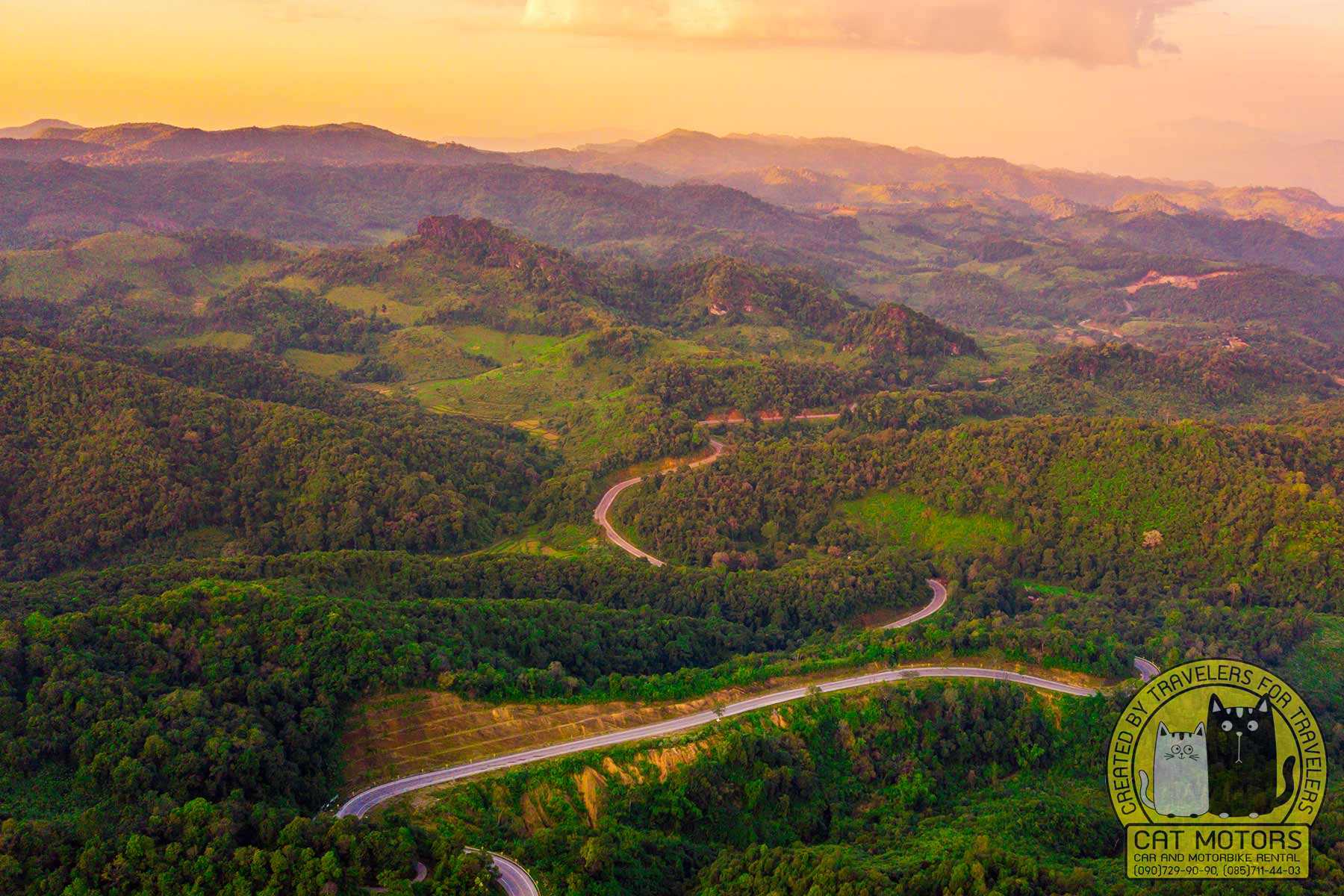
Places to visit
Thung Bua Tong Doi Mae Ho
Before you get to Mae Sariang, you can visit Ganesha Museum, Doi Inthanon, Great Holy Relics Pagodas, Wachirathan Waterfall and Mae Ya Waterfall, which you will meet on the way. All of these attractions are described in our Mae Hong Son Loop and Doi Inthanon travel guides.
Though the fields of wild sunflowers at Thung Bua Tong Doi Mae Ho, also known as Tree Marigold fields, are quite popular among locals, some visitors may find them relatively simple and unremarkable. This location has made its way into our travel guide as it lies conveniently along the route. However, if you have already experienced the stunning Queen Sirikit Botanical Garden or visited the Doi Inthanon Summit, the Tree Marigold fields may not be as impressive in comparison.
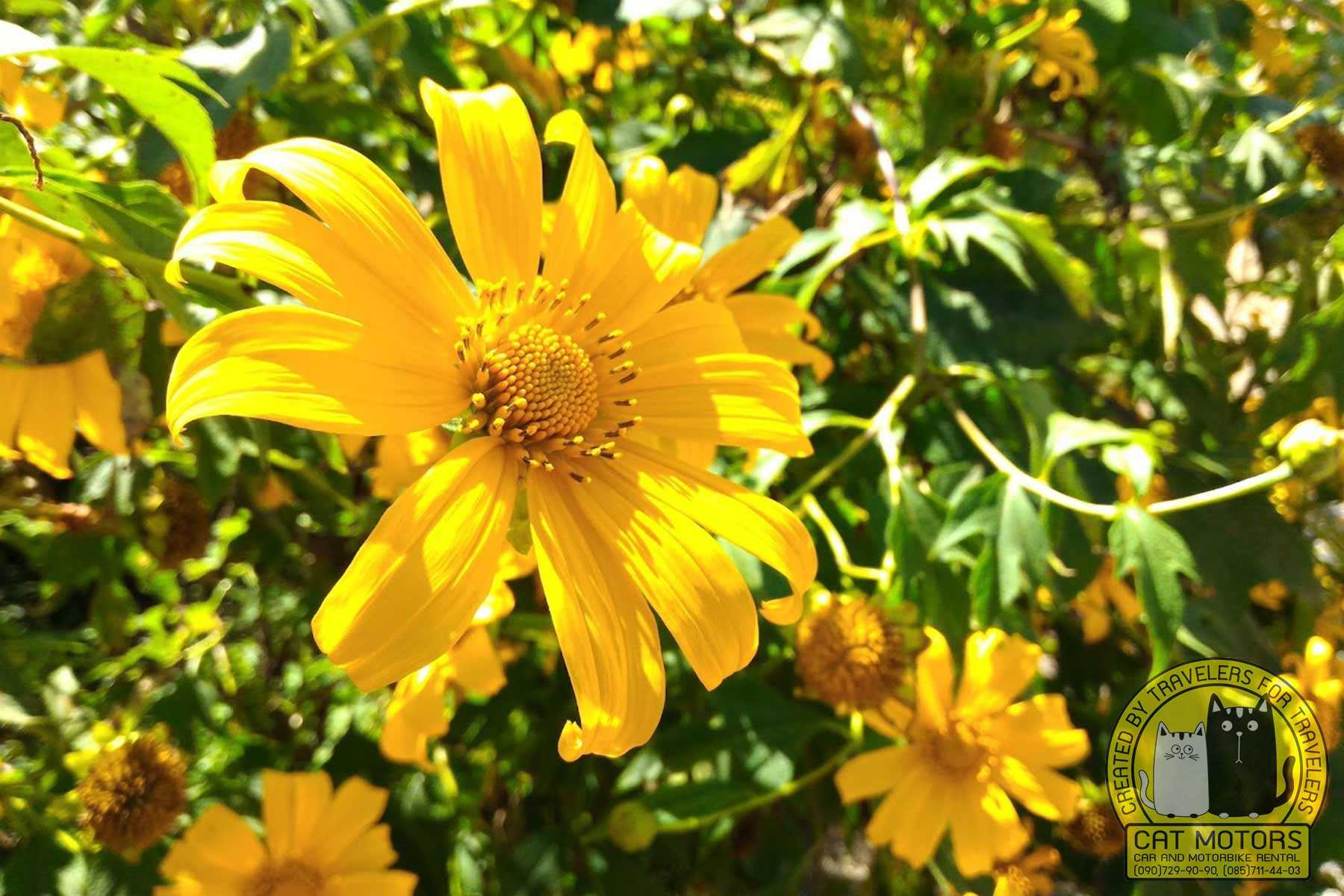
Moreover, if you are traveling along the Mae Hong Son Loop, and Mae Sariang is one of the stops on your way, a little later, you’ll come across the Doi Mae U-Kho flower fields on the route, which looks really stunning in the blooming season with the majestic mountains in the background. Nevertheless, it stays here.
Mae Sawan Noi Waterfall
In winter, during the blossoming of wild sunflowers at Thung Bua Tong Doi Mae Ho which paint the surrounding scenery in bright yellow colors, the district attracts many tourists wishing to visit this beautiful place and take pictures. However, the waterfall, which is located away from the main route at a distance of only 3 kilometers, is almost always deserted and secluded.
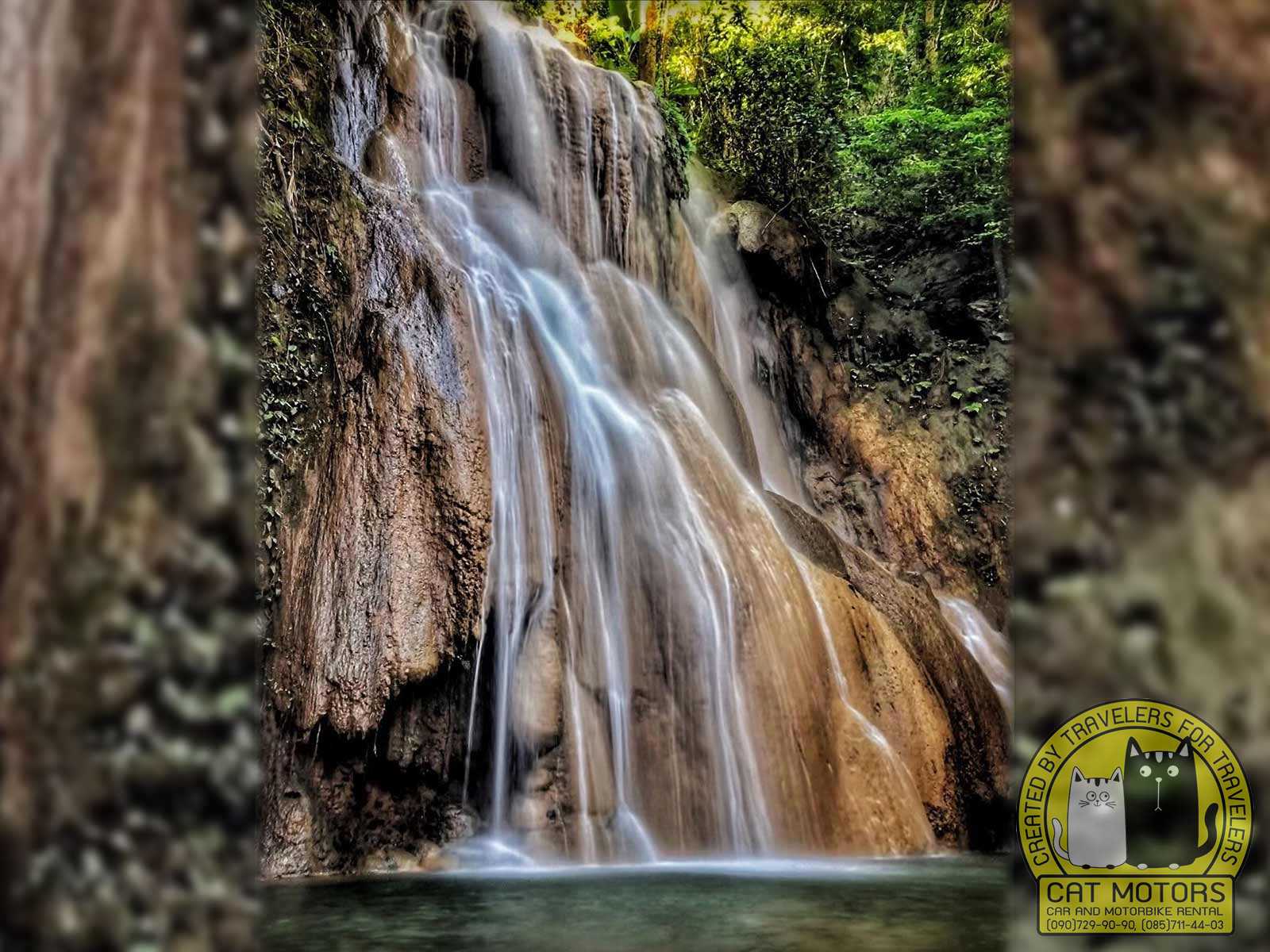
Unlike other waterfalls, the exploration at this site begins on the upper level, where you descend a path to reach the lower level. At each level, you can enjoy unique scenic views, shady green forests, and the area’s rich flora. Mountain Creek flows year-round, even in dry weather, and splits into two main streams. One stream flows into the Mae Sariang River, while the other flows into a pool on the fifth level, creating a beautiful natural spot to rest and relax during a full-day tour.
In the past, local forests were home to numerous wildlife species. However, deforestation and poaching led to migration and even extinction for some of them. Fortunately, several animals still inhabit the area, including red jungle birds, barking deer, gibbons, wild boars, tree monitors, Asian palm civets, pangolins, squirrels, chipmunks, turtles, various birds, bamboo rats, moles, colugos, bats and snakes. Despite this, some species remain endangered.
As mentioned earlier, this waterfall isn’t crowded with tourists because the trail leading to it is long and winding, deterring those who dislike hiking. Most of the time, once you arrive, you can enjoy solitude and commune with nature during a day tour. However, this location isn’t recommended for the elderly due to the steep path and the considerable amount of walking required.
Doi Lak Saen
Doi Lak Saen rises 1,139 meters above sea level. It is the highest mountain in Mae Sariang. It offers the best 360-degree panoramic view of the surrounding mountains covered with evergreen forests, not to mention the best vantage point to see the sea of mist in the winter morning. That’s why the Department of National Parks, Wildlife and Plant Conservation of Thailand decided to turn Doi Lak Saen into a nature tourist attraction.
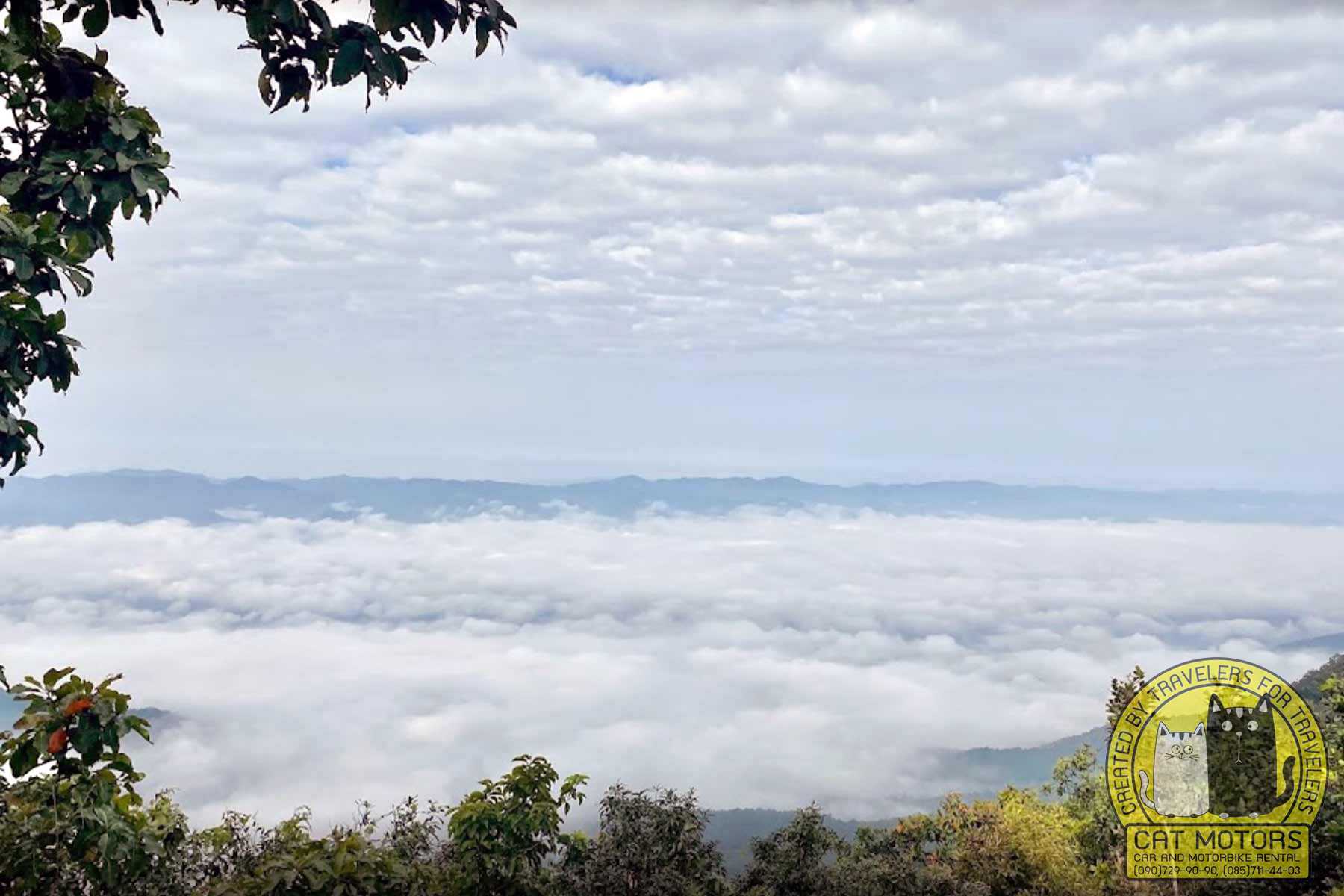
Visiting this place is a good opportunity for lovers of beautiful scenery to treat themselves to a beautiful and unforgettable view of the endless sea of mist that covers the entire town of Mae Sariang at the foot of the mountain in the morning.
The only way to get to the top of Doi Lak Saen is on foot. Walking the steep trail may take some time, but the surrounding scenery will allow you to engage with nature and forget that time is fleeting. Hiking the forest trail to the top of the mountain, listening to the sounds of nature and birdwatching are the true charms of Doi Lak Saen that hikers and birdwatchers can’t miss.
As with any adventure, it’s essential to prioritize safety. We highly recommend obtaining travel insurance before embarking on your trip. This will provide you with coverage for any potential medical expenses or emergencies, ensuring peace of mind as you explore the breathtaking landscapes of Doi Lak Saen.
Mae Sariang Museum
Situated along the bustling Wiang Mai road in Mae Sariang, a large, mesmerizing building in the mixed Lanna architectural style captures the attention of passersby. This unique style is a fusion of local northern Thai and Khun Yuam influences. Casual travelers might assume it’s just another temple, as there are many in northern Thailand, but in fact, it’s the Mae Sariang Museum. The museum’s prominent location on the Wiang Mai road makes it an easily accessible cultural landmark for both locals and visitors to enjoy.
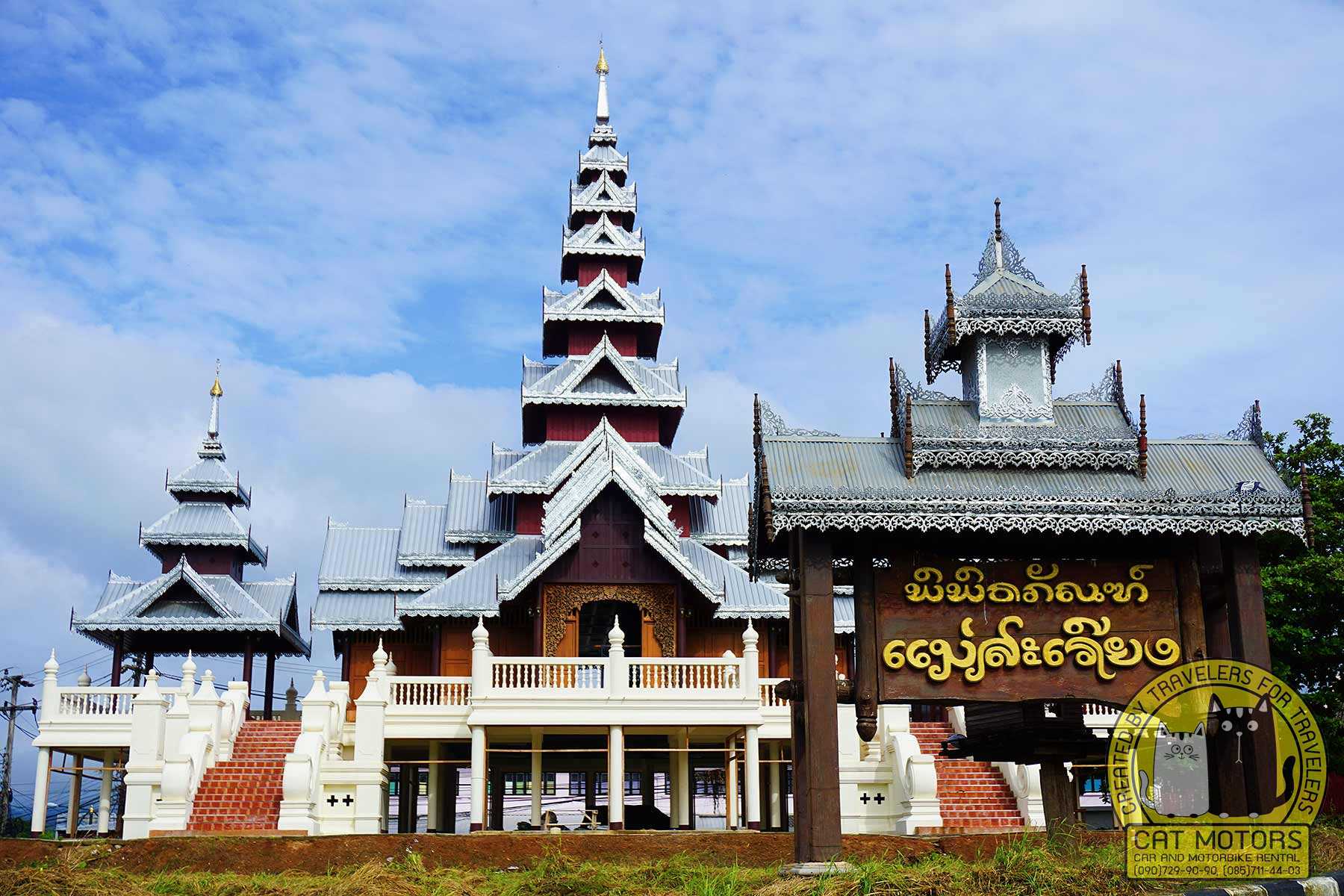
The two-story museum building is made of teak wood, its tiered gable roofs framed by gables with magnificent authentic geometric carvings. The intricate woodwork and blend of Lanna and Khun Yuam styles give the museum a unique character. The spacious space in front of the building is sometimes used for cultural shows and fairs.
The lower floor of the museum has an open floor plan typical of authentic Thai houses. The main room on the second floor contains relics of Buddha presented by His Holiness the Supreme Patriarch of Thailand back in 2006 and blessed in the museum on October 31, 2006. They were installed next to a statue of Phra Kru Panya Worawat, known to locals as Krooba Pha Pha, an arhat (saint) from the Lanna Kingdom. He is well known as a strict monk – one who followed the principles of Vinaya very strictly and was highly respected by the local people. Also in this museum is a white jade Buddha statue donated by the abbot of Wat Sribunruang. In this part of the temple, visitors can pay their respects and receive a blessing.
In the exhibition hall, tiny wax replicas show the old way of life of the villagers of Mae Sariang province, while old photographs tell of significant events and history of the past. In the corner of the main hall stands an elephant dragging logs, elegantly carved from golden teak wood. The craftsmanship of the wood carver and attention to every detail has given the statue an impressively realistic look. This statue reminds visitors that Mae Sariang was very rich in golden teak wood in the past.
Every exhibit in this museum is a testament to the priceless history of Mae Sariang, which the locals try to preserve for future generations. The blending of Lanna and Khun Yuam architectural styles in the museum’s design serves as a visual reminder of the region’s diverse cultural influences.
Phra That Si Chom – The Relics of the Four Peaks
These four temples, located in four different directions from town, are known as the Relics of the Four Peaks, have a long history and are highly respected by locals and visitors.
If you visit Mae Sariang but do not visit the Relics of the Four Peaks, people will say that you have never been in Mae Sariang. Moreover, there is a belief that a person who has expressed his reverence for all four temples is a wise and noble person who favors good fortune in life.
Wat Phra That Chom Chaeng
Wat Chom Chaeng, a Lanna temple with mixed architectural styles, is located in Mae Sariang town, opposite the museum. Visitors to the temple can enjoy the panorama of Mae Sariang District, especially around sunset. A rural view with rice fields and people’s houses may be found to the east. On the temple grounds is a pagoda, which holds the sacred relic – the hair of Lord Buddha.
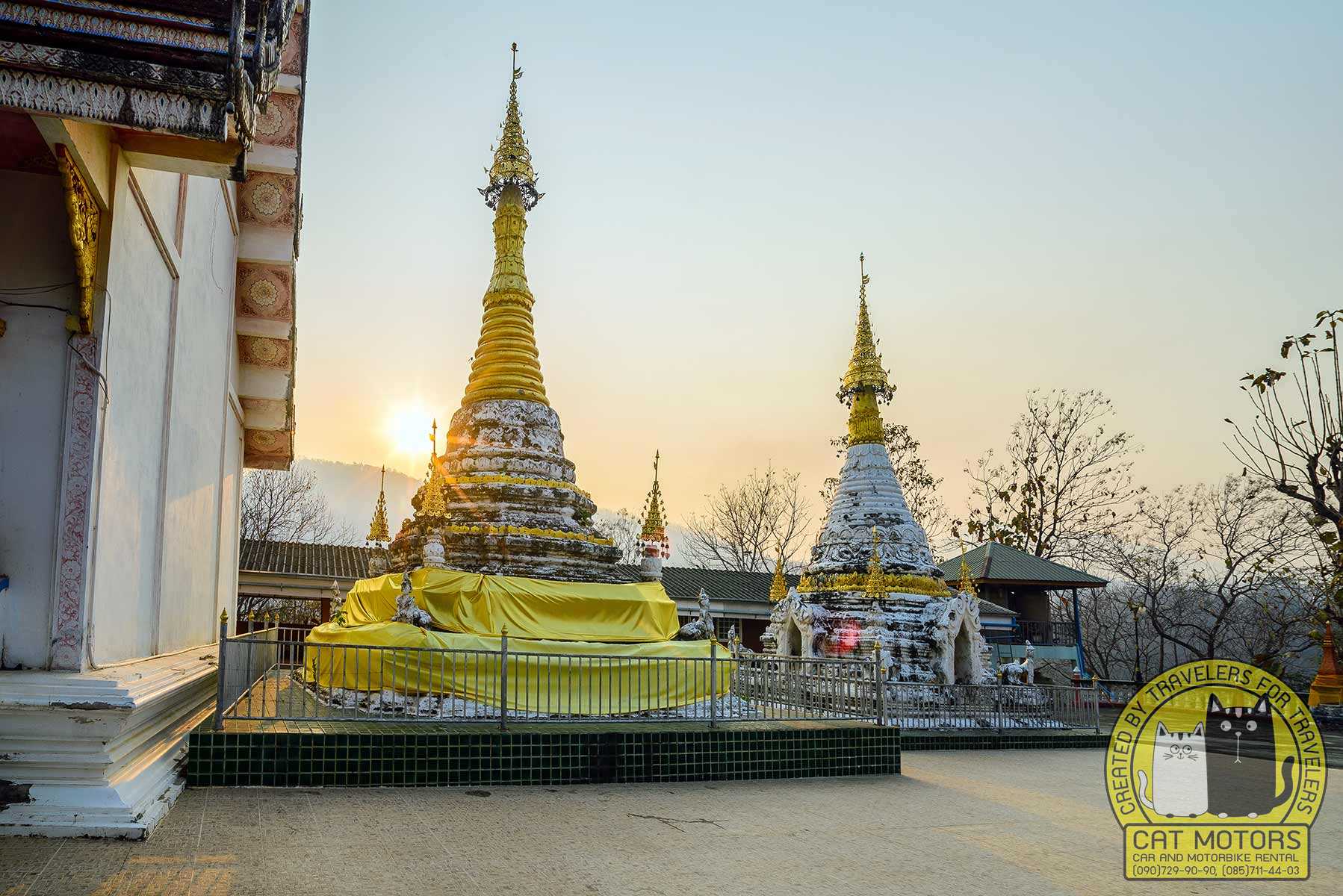
The temple was erected around 1000 B.E. by four hermit brothers to be a sanctuary of worship and protection for the residents of Yuam city. The mural paintings inside the Ubosot reflect the story of Vessantara and Lord Buddha’s life. The temple is open daily, including holidays.
Wat Phra That Chom Thong
Wat Chom Thong is a historic Buddhist shrine and one of the “Relics of the Four Peaks.” The temple is located east of Mae Sariang. At the top of the mountain, you will see a huge sacred statue of Luang Pho To Phra Buddha Mani Ming Mongkol. It is the largest Buddha image in Mae Hong Son, measuring 15 meters high and 19 meters wide, the appearance of which has been reproduced based on 32 physical characteristics of the Buddha.
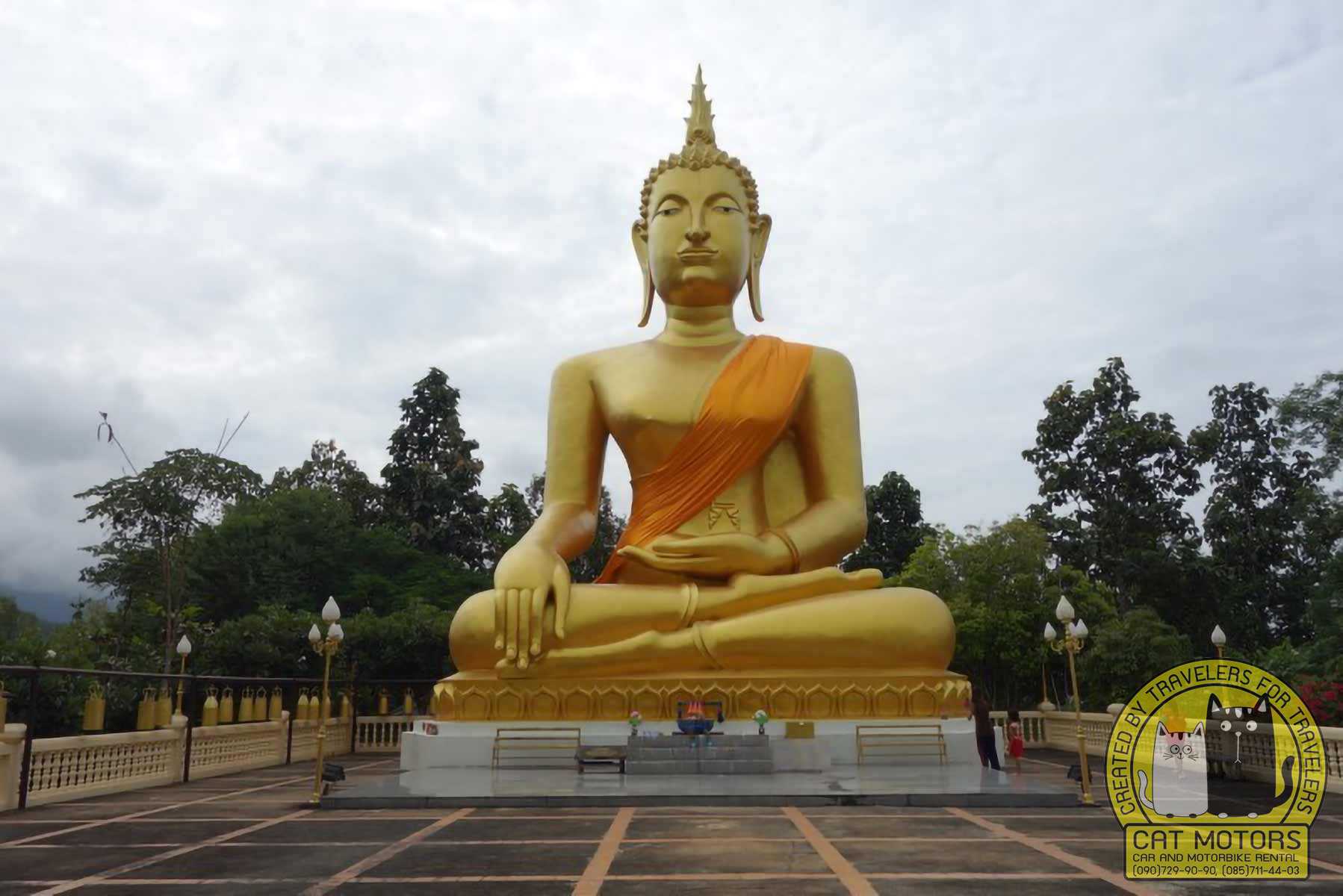
From the top of the mountain you have a beautiful view of Mae Sariang and the green rice fields. It is highly recommended to visit the temple in the evening, because watching the sunset from the observation deck of the temple is very romantic and fascinating.
Wat Phra That Chom Mon
The chedi is located on top of a mountain, northwest of the city, from which you have a splendid and inspiring view of the surrounding countryside. From a bird’s-eye view you will see small villages surrounded by rice paddies; the winding Yuam River that loops among the fields before disappearing from view; and the vast, stunning countryside. If you are a fan of landscape photography, you will surely love this place.
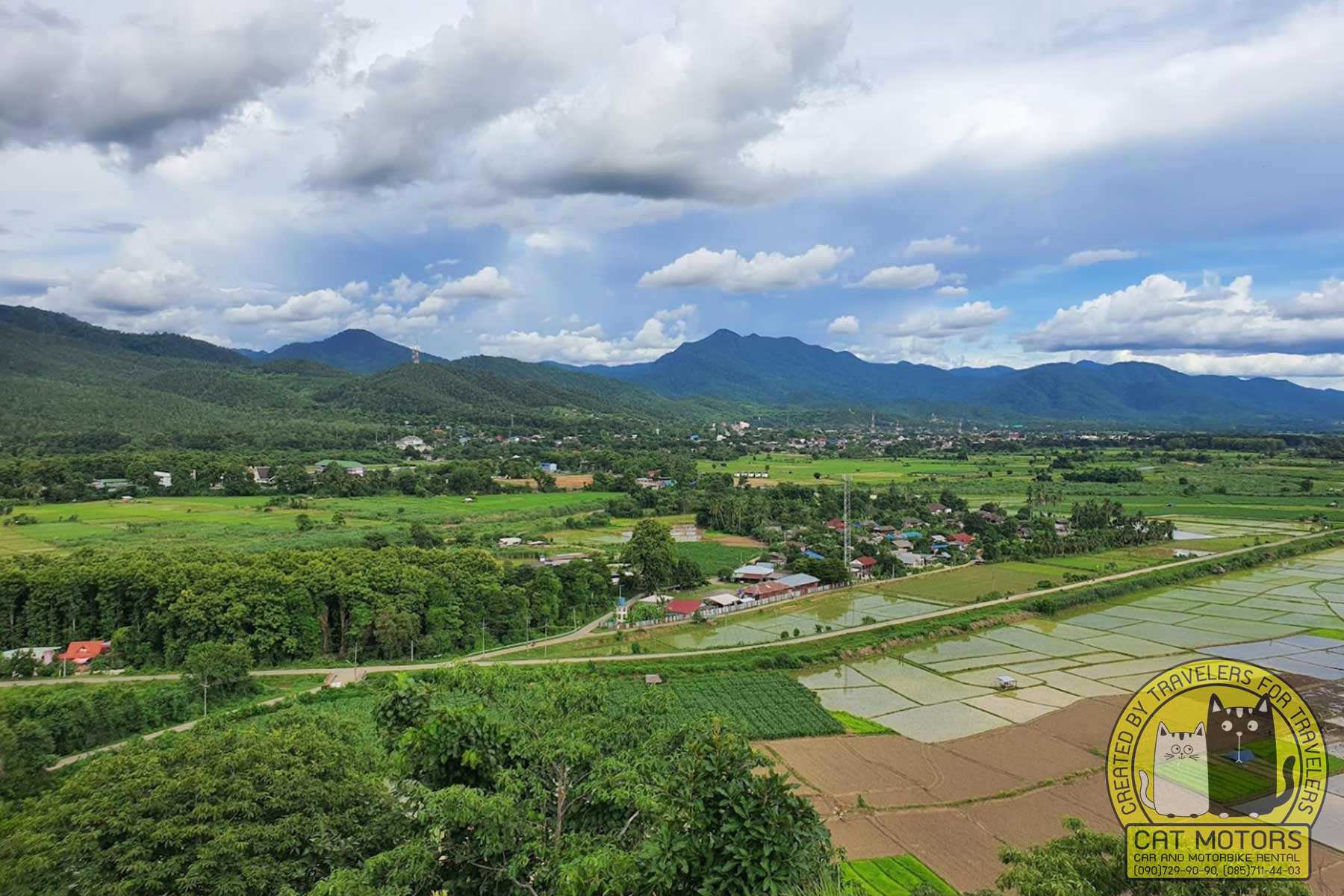
The temple has no evidence of its foundation. Historians speculate that the temple was first built during the reign of Phra Chao Saen Muang Ma, the seventh king of Chiang Mai of the Mangrai dynasty. He ordered Chao San Kam, his royal viceroy, to build this temple in 1392. At the end of his reign, after his death, the ashes of Phra Chao Saenmueang Ma were buried in the same temple in Ku San Kam Pagoda, which is still next to the main hall.
In 1600, after King Naresuan liberated Siam from Burmese rule, he gathered the Tai Yai, Mon, Karen and Lava people from Myanmar to join the Thais in these lands. Among them were the Shan people, an ethnic group from Myanmar who would later form a significant part of Mae Sariang’s population. King Naresuan also persuaded King Mon and his servants, who had been forced to migrate by the wars, to join him. Together they founded a new settlement on the site and restored the temple to its former glory.
Today, Mae Sariang is a diverse and vibrant community where the rich cultural heritage of its people, including the Shan, is preserved and celebrated. The temple’s history reflects the diverse roots of Mae Sariang’s population and stands as a symbol of unity among the different ethnic groups that have contributed to the region’s unique character.
The people of Mae Sariang, including the Shan community, take great pride in their shared history, as evidenced by their dedication to preserving the temple and its historical significance. The town’s multicultural heritage is visible in its traditions, festivals and the daily life of its inhabitants, making it a fascinating destination for visitors interested in experiencing the genuine warmth and richness of Thai culture.
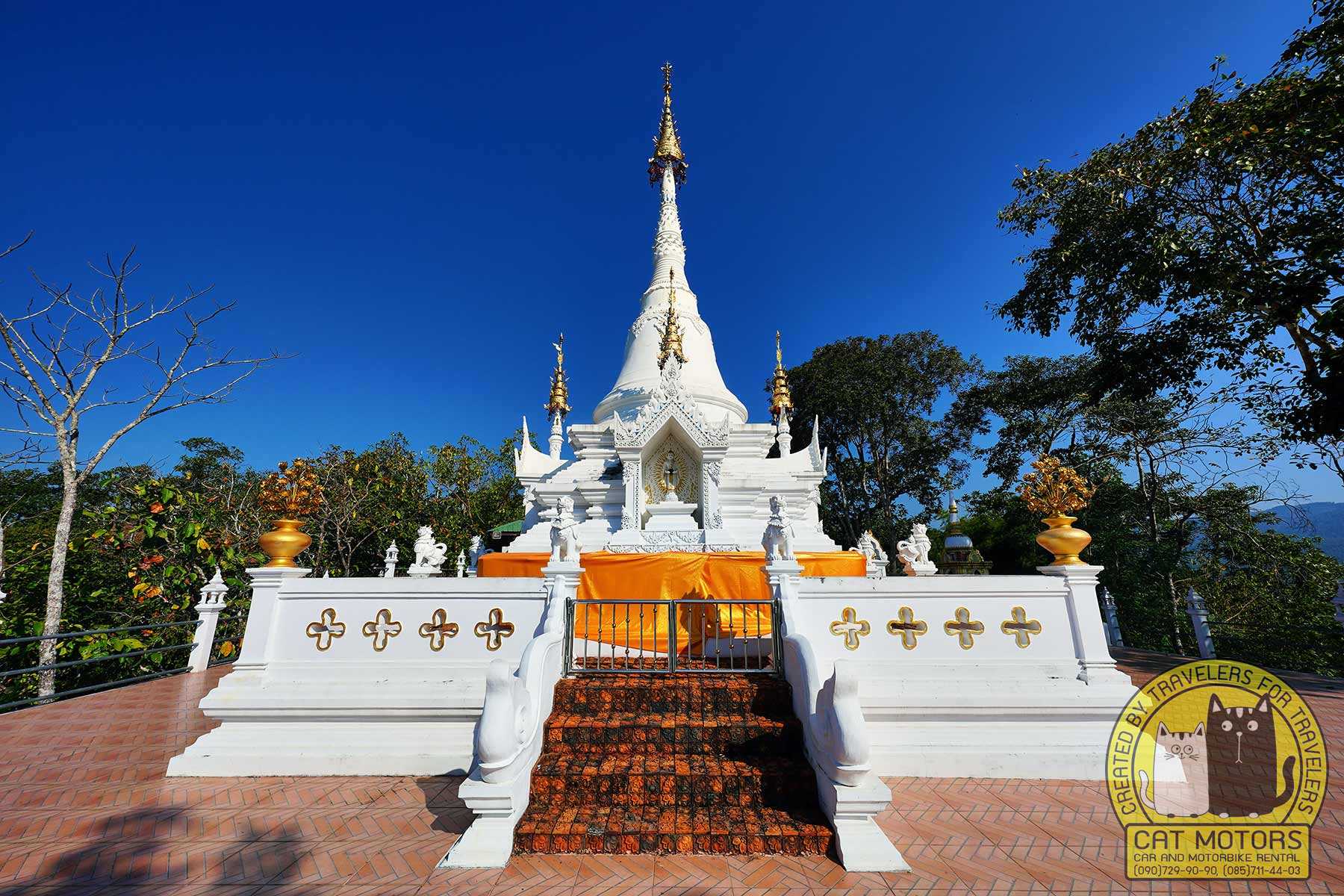
Over time the pagoda became dilapidated and eventually collapsed. In 1910, under the guidance of Karen hill tribe elders, the pagoda was rebuilt. In 1997, it was modernized again, and the pagoda became more grandiose. This time, relics of the Buddha were also placed inside the pagoda. The devotion of Buddhists and the strength of their faith have transformed a small, dilapidated old jungle temple into the famous holy Wat Phrathat Chom Mon.
Wat Phra That Chom Kitti
The fourth temple was built under the influence of the Lanna style. Its architecture is painted pure white, except for the golden pagoda top, which houses the relics of the Buddha.
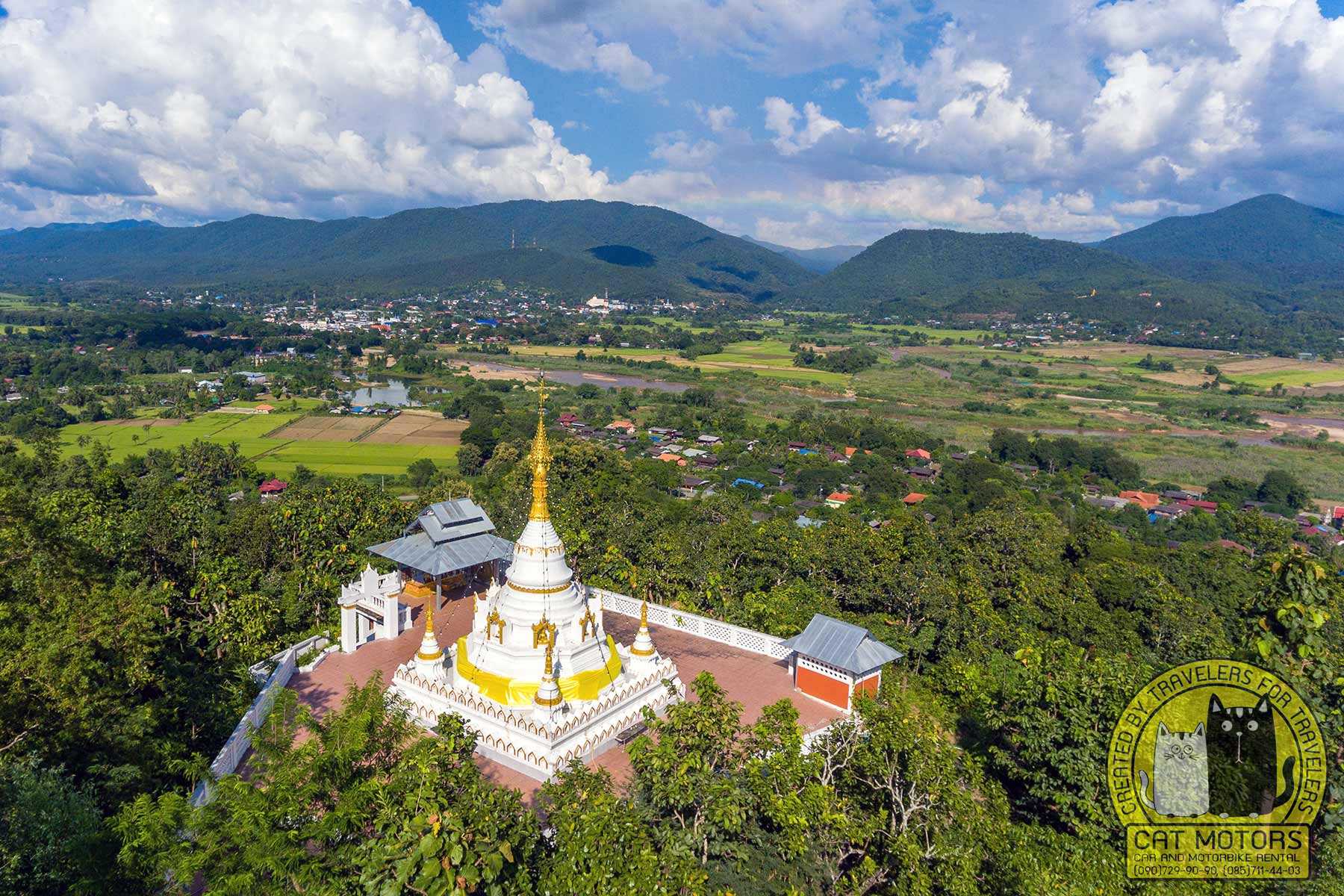
The temple was built in 1713. According to local lore, four hermit brothers lived in a nearby cave. After they finished their training with the eldest monk, they decided to settle in four different directions of Yuam (the original name of the Mae Sariang area).
The older brother was skilled in curing disease and preparing potions. It was rumored that one sip of his potion could bring the dead back to life. He settled on Mount Chom Kitti. The second brother could turn lead and other metals into gold. So, he named the mountain he settled on after his ability, Doi Chom Thong, which means “golden mountain” in Thai. The third brother settled on Doi Chom Chang (not to be confused with Doi Chang). As a sorcerer, he could summon wind and rain. The younger brother was famous for his mighty strength and could walk through the air. He settled in Doi Chom Mon.
It can be said that Phra That Chom Kitti is the chief relic among all the relics of the four peaks, and it is still held in high esteem among the people.
Morning Market
It is a large covering morning market in the center of Mae Sariang, selling fresh fruits and vegetables from local farms, groceries, clothing and consumer goods, second hand. Here you can buy almost everything that an ordinary person needs in everyday life. The fresh market is open from 2:00 a.m. to 8:00 a.m., the other part of the market is open during the day.
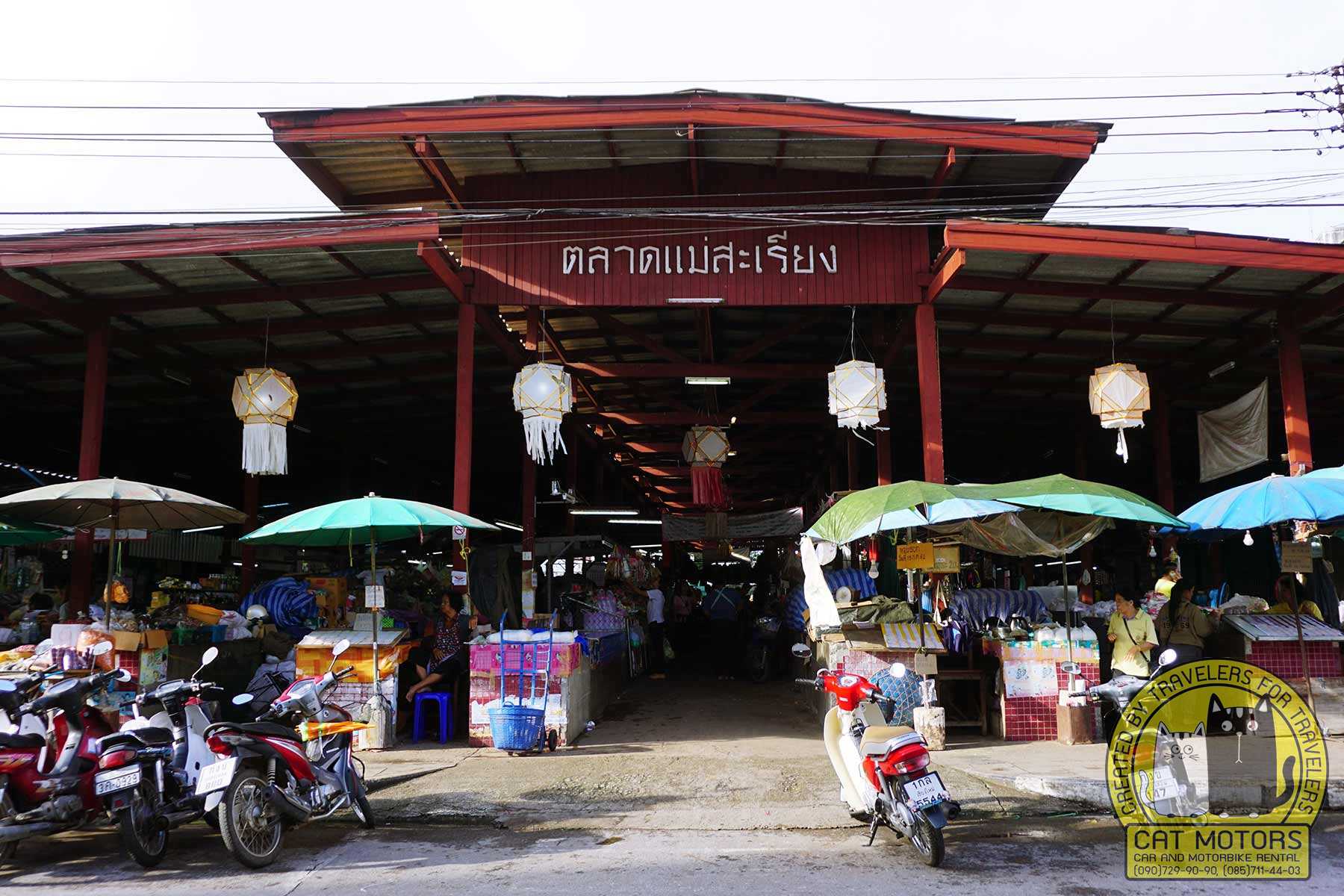
If you visit this place, be sure to stroll through the food stalls and try the local crispy pork, sai‑ua pork sausages with spices and herbs (this delicacy has a different taste than in Chiang Mai because of the Shan national cuisine that has influenced this region), miang kham (Thai: เมี่ยงคํา – roasted coconut shavings, small dried shrimp and roasted peanuts, finely chopped shallots and ginger, slices of lime, all richly drizzled with sweet and spicy palm syrup and wrapped in edible cha phlu leaves), and dishes of fish caught in the Salween River. And, of course, you’ll find here freshly brewed coffee and tasty Shan sweets.
Google Map https://goo.gl/maps/XxDozN1ifCznnc3m8
Wednesday Walking Street
The Wednesday Walking Street in Mae Sariang (Google Map) is a lively and vibrant weekly market where locals and visitors can indulge in the rich cultural experience of the town. The pedestrian-only street features a plethora of food stalls, offering both authentic Thai cuisine and unique regional dishes inspired by the diverse local communities, including the Shan people.
Shoppers can also find an array of handmade crafts, souvenirs and clothing created by talented local artisans. The mix of products on display showcases the rich cultural heritage and traditions of Mae Sariang. As you stroll along the Walking Street, you’ll be immersed in a lively atmosphere, surrounded by the sounds of cheerful chatter, laughter and live music from street performers. It’s a perfect opportunity to engage with the locals, try new foods and create lasting memories of your time in Mae Sariang.
Salawin National Park
The Salween National Park office area is a natural viewpoint where you can explore the national park’s nature and watch the early morning rainforest filled with mist. There is a hiking trail of about two kilometers for exploring nature, plants and natural wonders, which takes about two hours to walk and explore. The main activities for travelers here are hiking trails, caving and geological exploration, stargazing, mountain biking and river boat cruises.
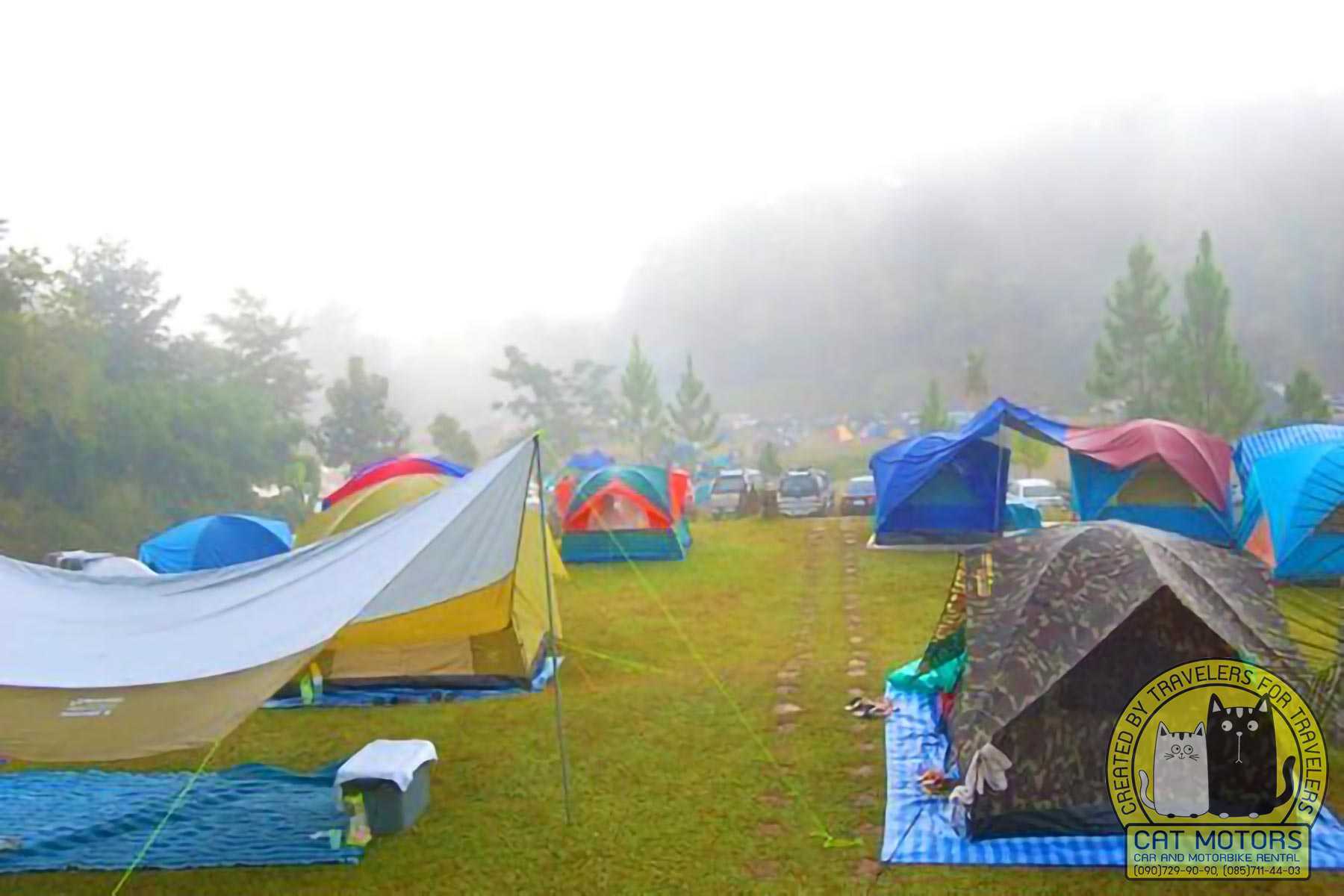
There are 3 guest houses in the park, which can accommodate 24 travelers. There is also a camping area with parking lot that can accommodate 200 campers a day.
Remember that some things are forbidden in Thailand’s nature parks. Some travelers may think this can be ignored, but there are many cases of people being detained and sent to prison for picking mushrooms and useful plants or making a fire in a national park.
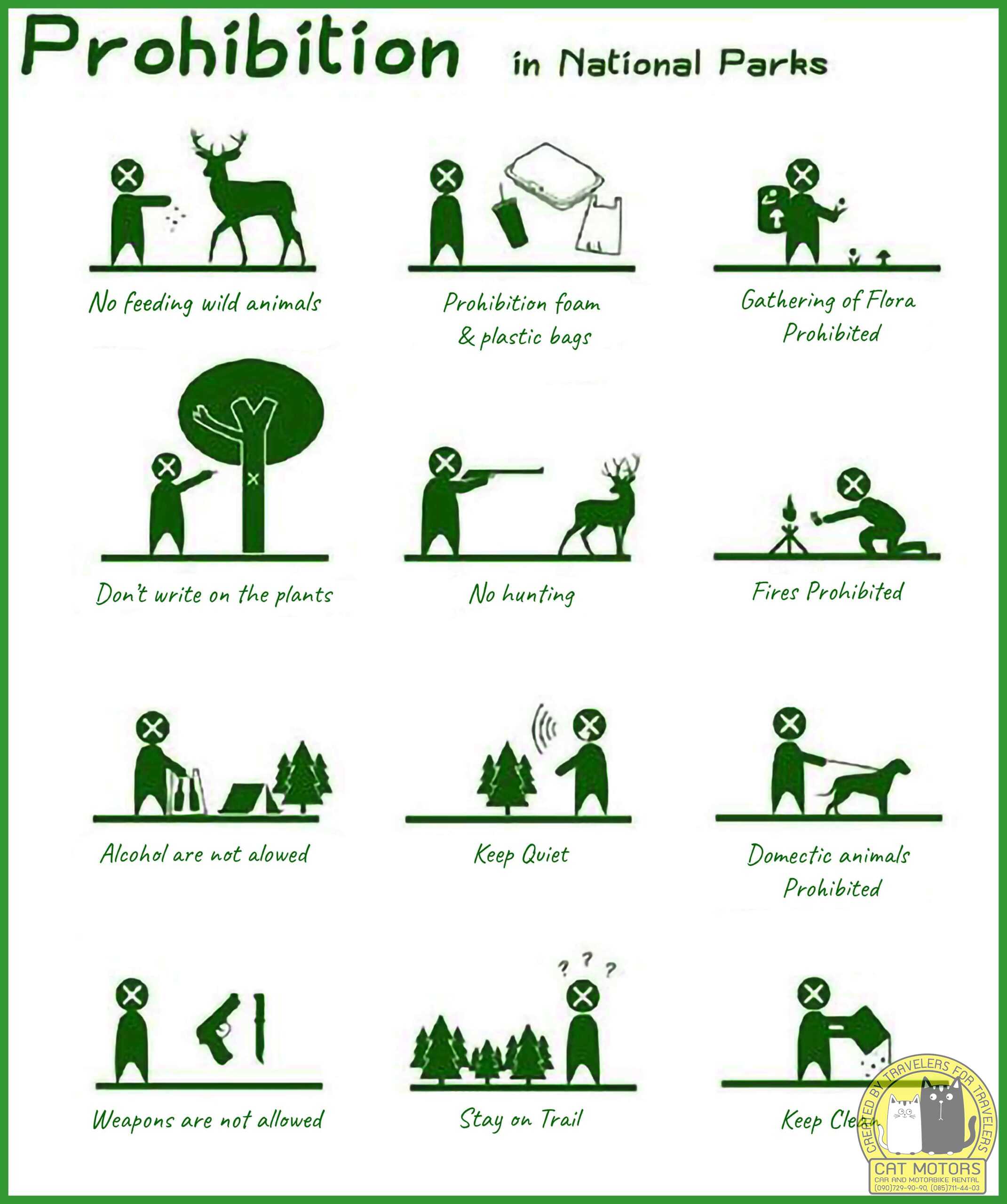
Ton Sak Yai
One of the highlights of the Salawin National Park is a giant old teak tree, 450 years old, 68 meters high, with a trunk circumference of 840 cm.
Google Map https://goo.gl/maps/gDRsaid2rzVCbDkD7
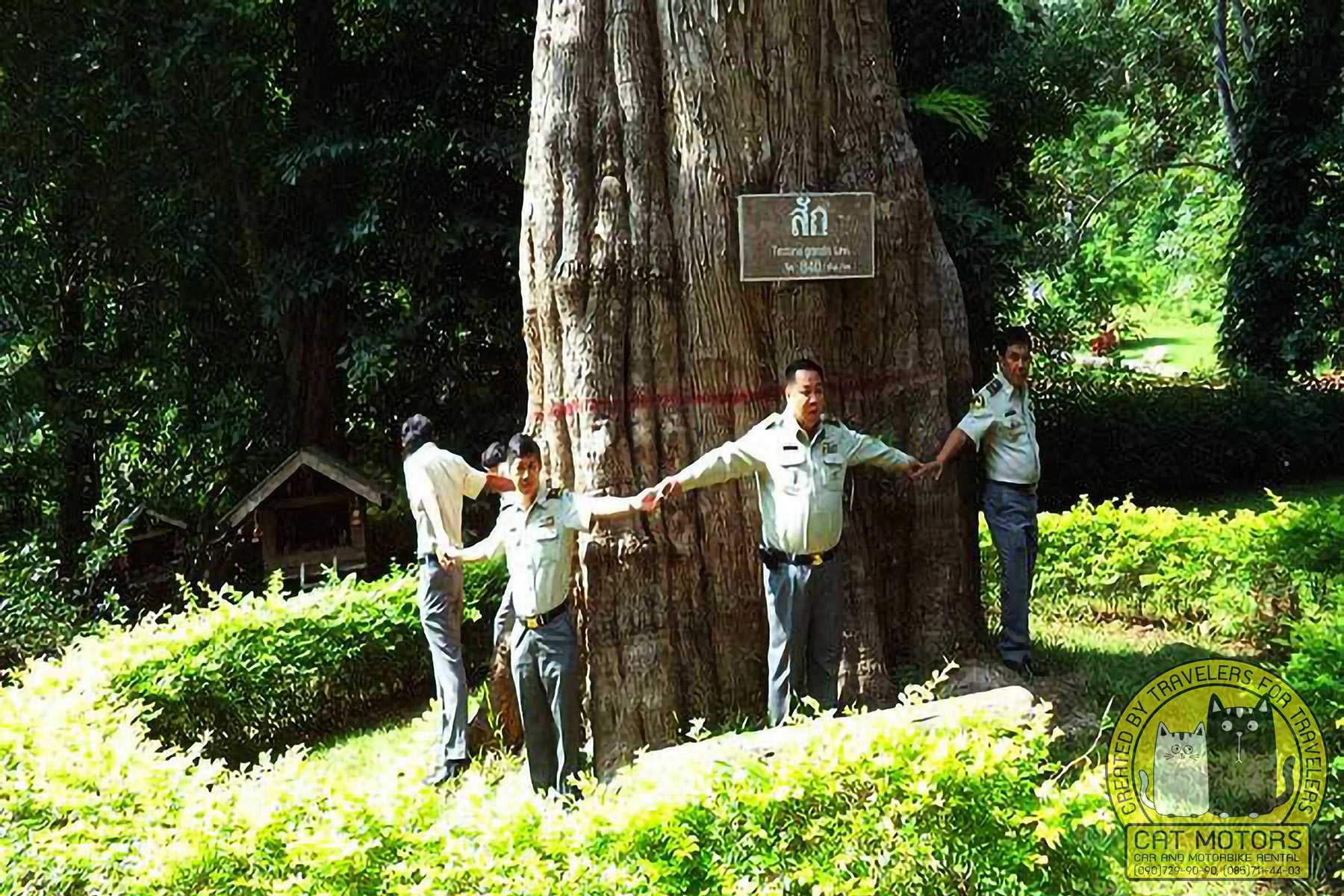
Salween River
The river originates in the snow-covered Himalayas, then flows through China, Myanmar, Thailand and then returns to Myanmar at Bay of Martaban before flowing into the Indian Ocean. The Salween River is 3,151 kilometers long and is the natural border between Myanmar and Thailand in Mae Hong Son Province, flowing through Mae La Noi, Mae Sariang and Sop Moei districts for a total distance of 120 kilometers.
In this part of our guide, we will also touch on exciting places to visit in neighboring areas. You won’t find this in other tourist guides because the authors don’t quite understand that the guidebook is about the journey, not a list of attractions located within the administrative boundaries of a municipality. After all, we drove hundreds of kilometers to get here, and all these sights were very close to our destination. So why should we ignore it?
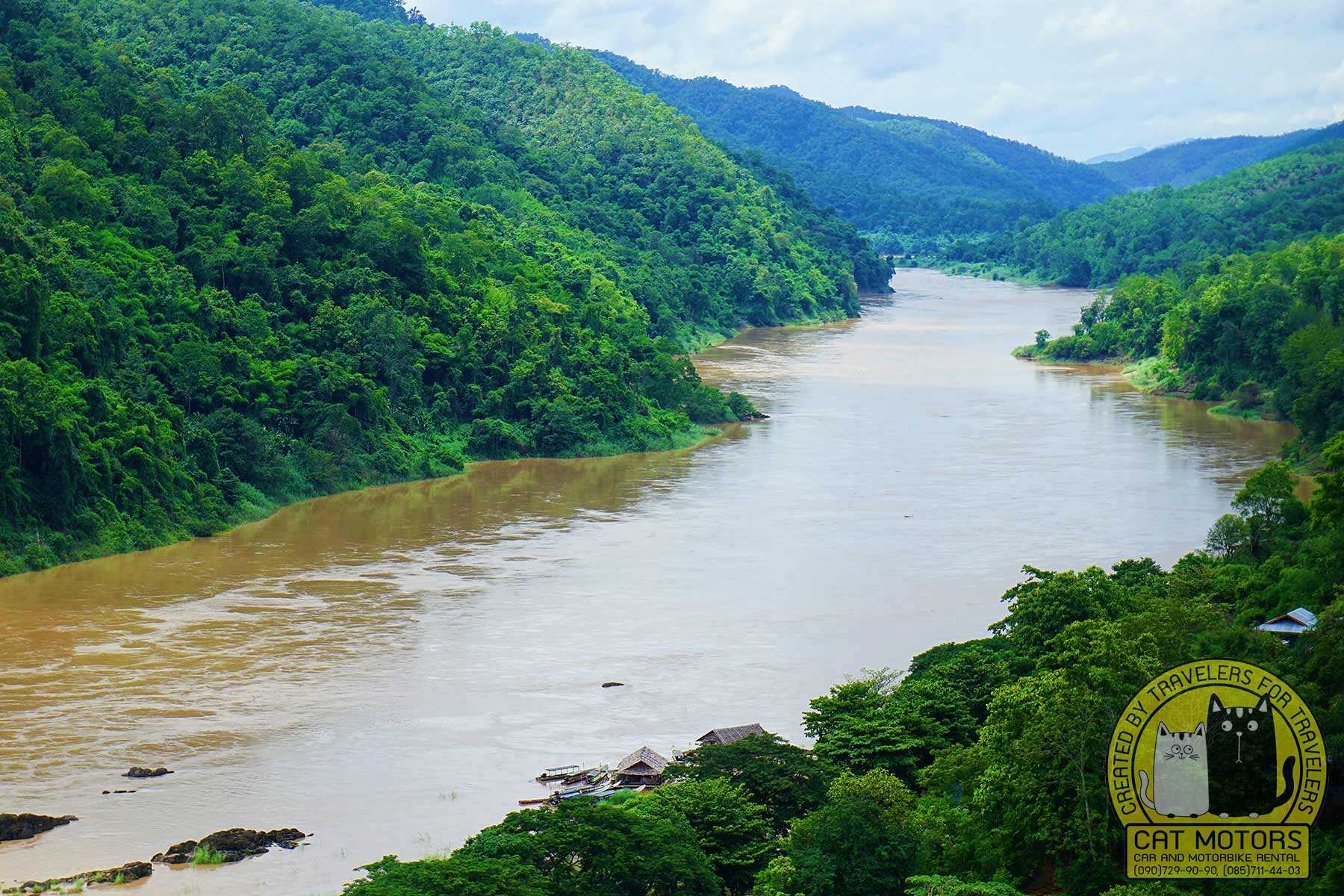
The river is especially beautiful in winter, when the deciduous forest changes color from deep green to brilliant red and bright fiery yellow, and a thick blanket of mist covers the river as far as the eye can see.
In summer the water level is lower, but it is so crystal clear that you can see the sand under the water. Also, during the summer tides, you will see beaches with fine white sand on both sides, interspersed with large rocks towering over the water, which creates a magnificent landscape different from the winter one.
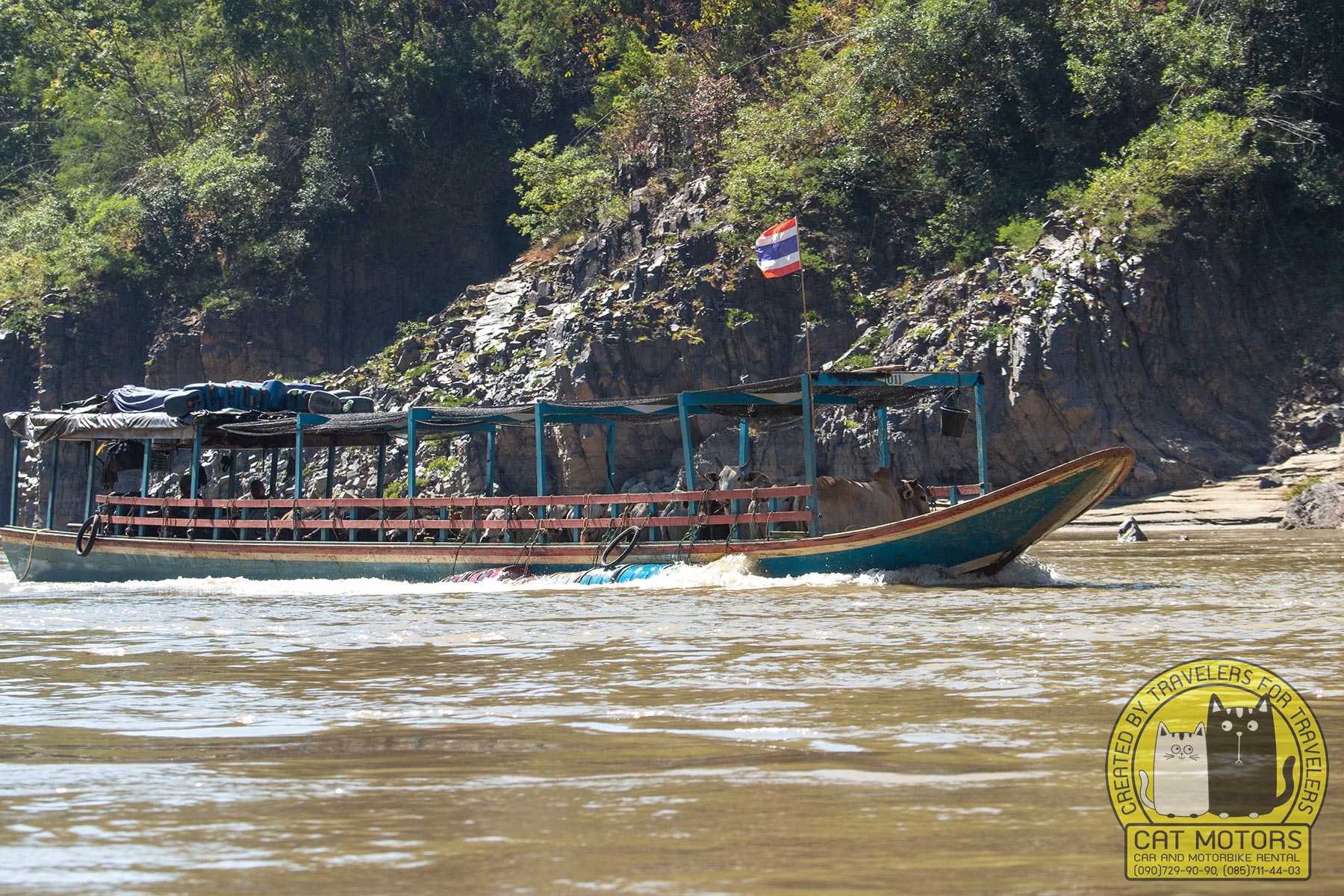
There are many interesting things to do here. In addition to admiring the beautiful waterfront scenery in the national park, you can also explore the different plants on the nature trails and even meet the wild animals that live in these forests. But first things first.
Phra That Mae Sam Laep
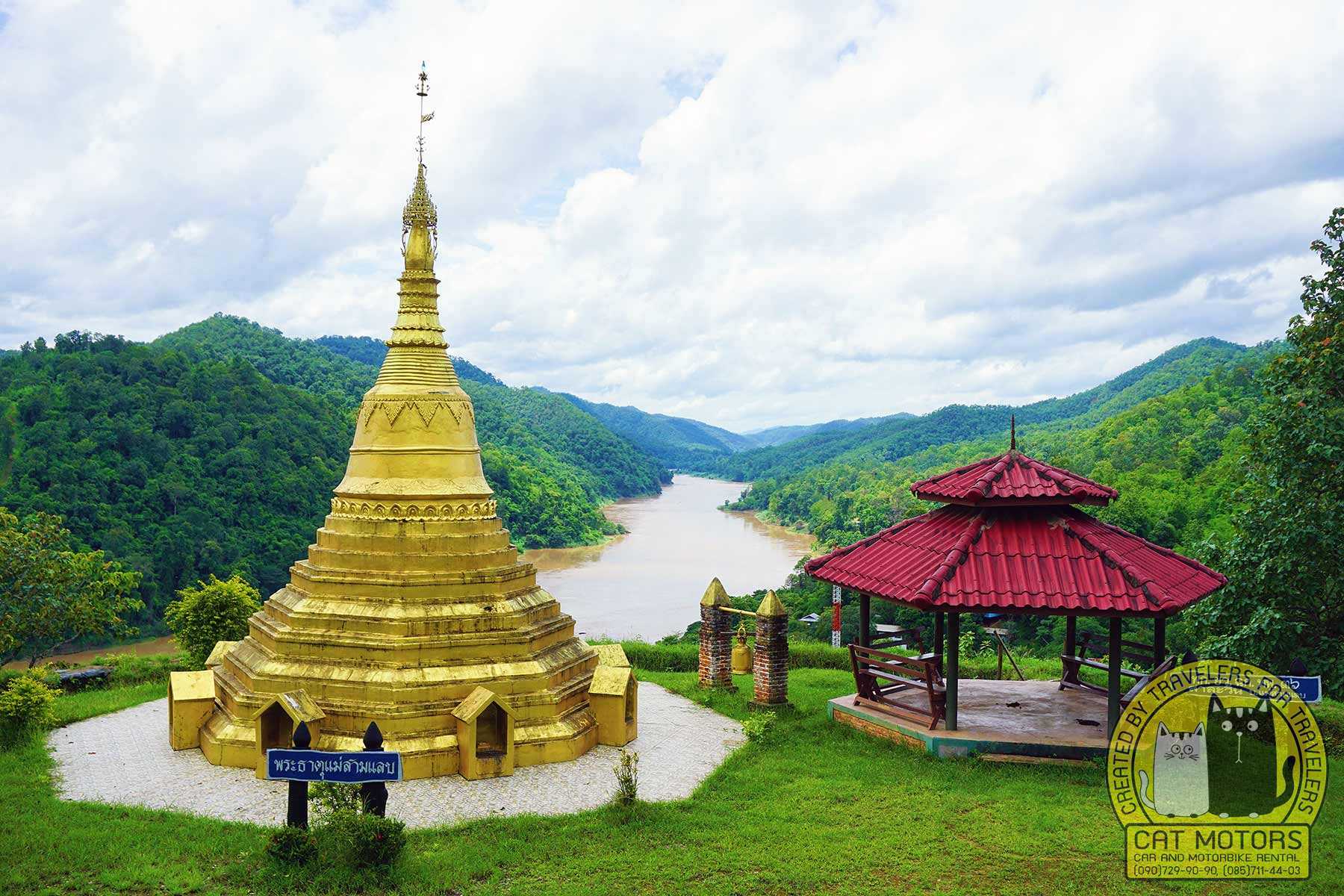
This is perhaps the best and most picturesque view of the Salween River. The golden pagoda is shimmering in the sunlight, the breathtaking view of the river and the mountains with lush greenery. It all looks stunning and ready to meet you for numerous selfies.
Google Map https://goo.gl/maps/5xXf1wnQxLfgtrz48
We could not find information about the pagoda in either English or Thai in public sources, although it has “Phra That” status, which means that it houses the relics of the Buddha. We’ll be sure to update the information a little later as we learn more about the history of the place.
Pier
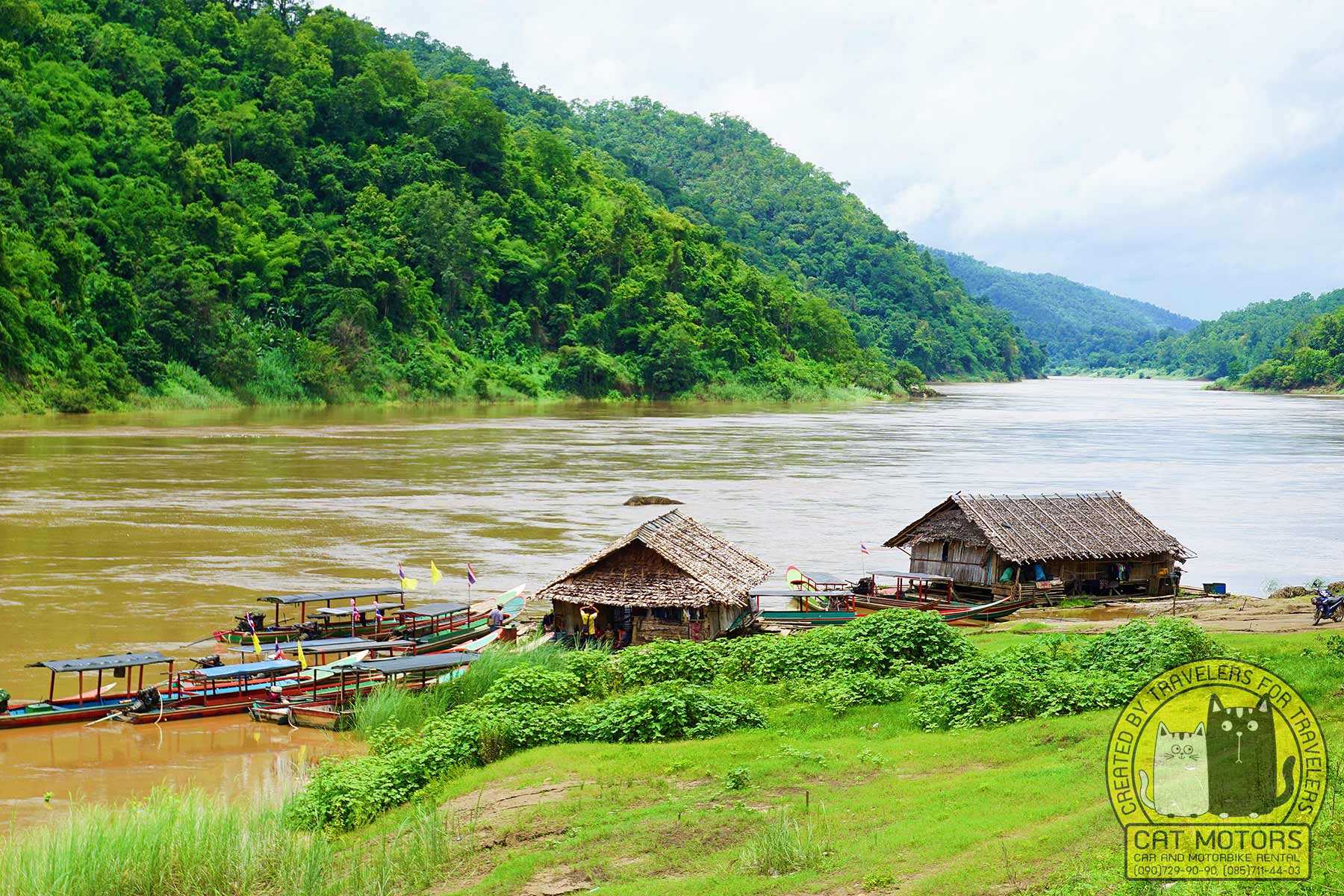
Of course, a rustic pier with a few wooden boats is hardly unusual for a foreign tourist, but it is not just a pier… This pier is unique in that it is the local center of cross-border trade! After all, this is where boats from Myanmar arrive to bring goods to the people in Thailand.
Google Map https://goo.gl/maps/s1g4EhTPDRUiQiNCA
But the main thing about this place is that it is a starting point to remote areas that are not always accessible when traveling overland. Also, the most popular activity here is cruising the Salween River. That’s why we’re here. You can charter a long-tail boat from the villagers of Ban Mae Sam Laep and choose from two suggested river routes, where you will then be taken:
Boat trip from Mae Sam Laep to Tha Ta Fang
This village is predominantly inhabited by Karen Christians, but in addition to them live here representatives of other Thai hill tribes, as well as Burmese and even Kala Indians. Once upon a time, this place was very busy because of cross-border trade, but because of constant border armed conflicts in the past, it has become deserted and lost its former commercial appeal. Most of the houses here have no electricity, and only a few have solar panels installed, providing their owners with minimal electricity needs. It’s a good time to give up your modern devices, forget about the Internet and look around at the real rural life of northern Thailand.
The trip lasts about 40 minutes one way and the round trip cost is 1,300 baht. If you want to stay overnight in this place, then you will need to pay extra 500 baht to the boat owner for the overnight stay.
Abandoned police station
The first police barracks in the area was built more than a century ago, in 1901. The police officers’ task was to ensure the safety of the loggers of precious teak wood. In those days, the Salawin River was a logging route, and teak wood from Thailand was floated first to Burma and then shipped to European countries, mainly Great Britain. Later, a customs station was established here. At that time, the area was used for trading diamonds, gems, jade and gold, which traders brought from Karen State in Burma. Gem traders who wanted to sell their goods in Thailand had to register and obtain a permit to trade, after which they would go to the gem market in Mae Sariang. But in 1967, after the building was fired upon from across the river and a police officer was killed in a shootout, the checkpoint was permanently closed.
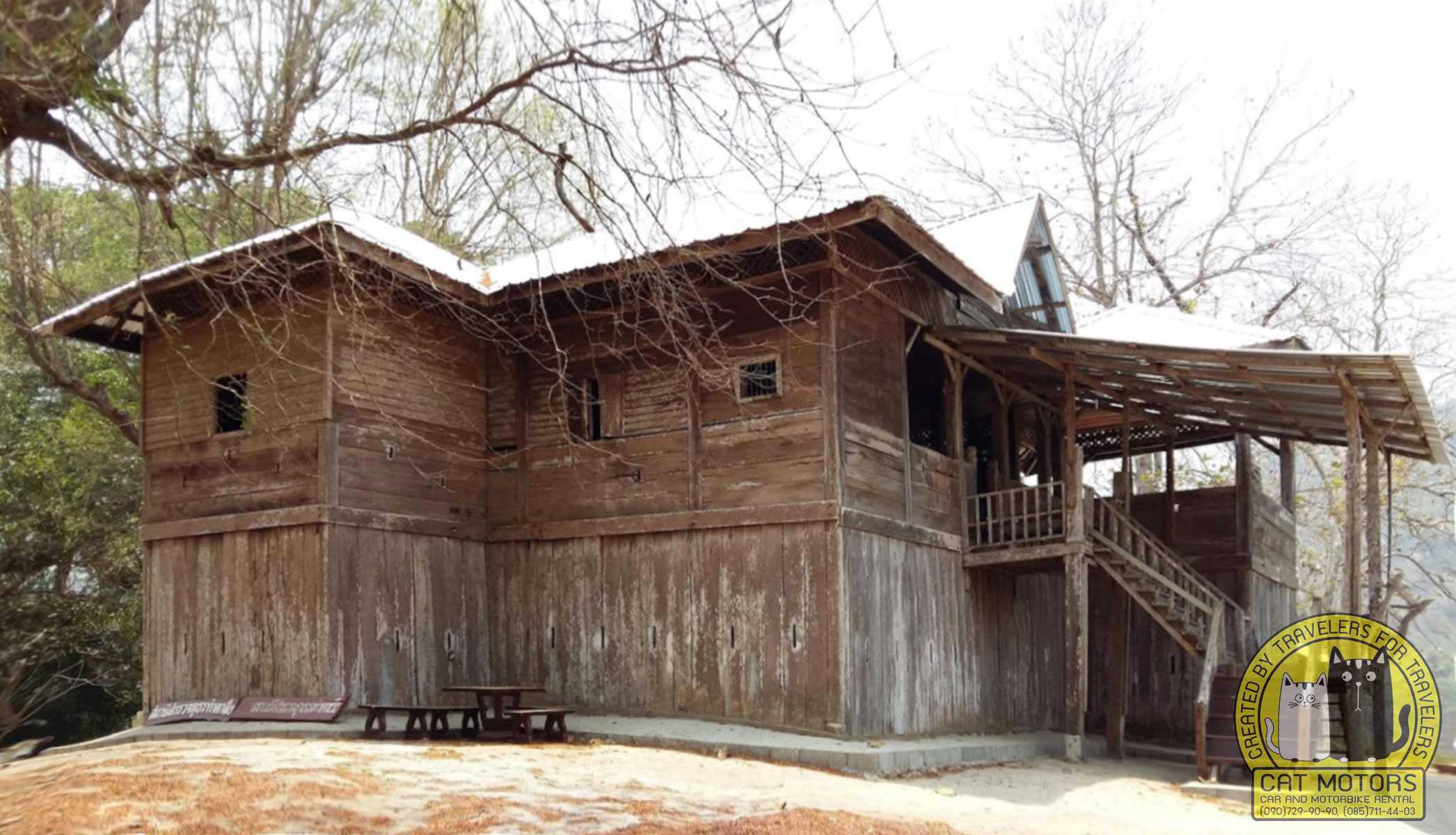
Now this old historic house is a place of attraction for local and foreign tourists, which you can always meet here.
Google Map https://goo.gl/maps/De3fcYNrwqv5DWXH6
Haad Taen Kaew
The sandy river beaches deserve special mention. But we don’t think there’s any point in describing it, because it’s already clear how beautiful it is.
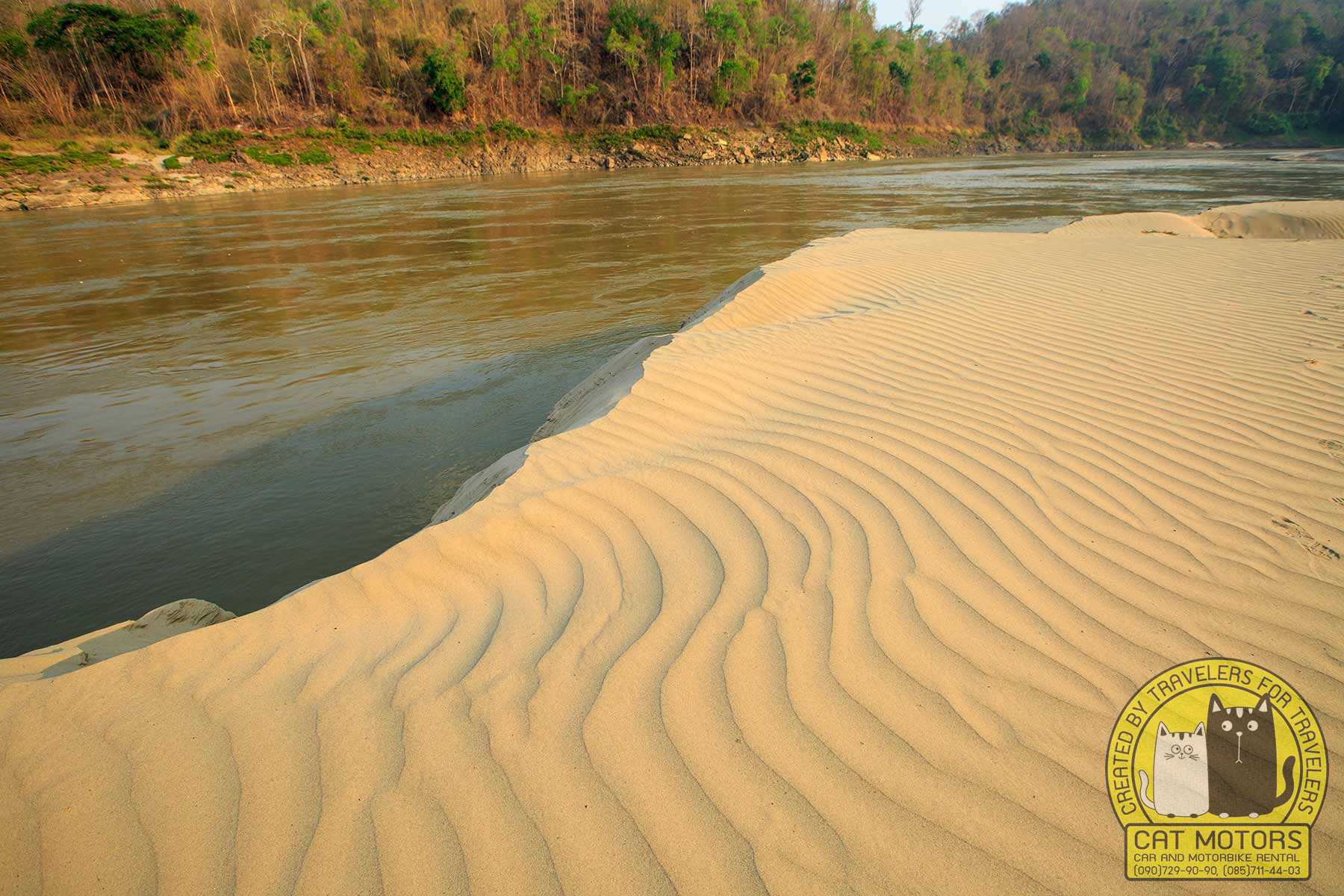
It’s time for a beach relaxation. Did you bring your beach towel?
Google Map https://goo.gl/maps/58ryCWEn6TThSJEM9
Mae La Oon refugee camp
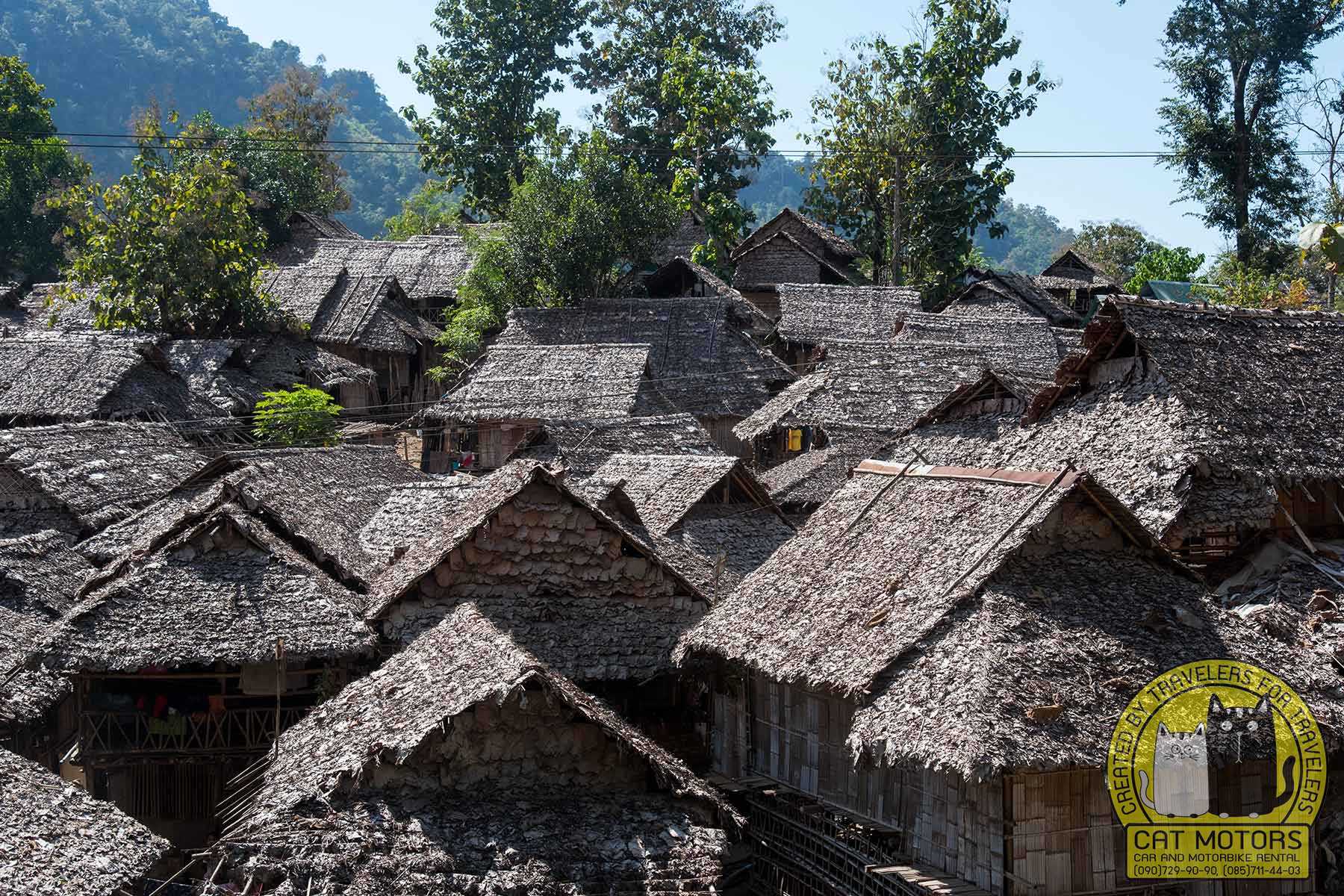
From Tha Ta Fang village, you can go to Mae La Oon refugee camp. This trip takes about two hours. The cost of chartering a boat is 1,500 baht. Once here, you can combine the pleasure of the river cruise with learning about the lifestyle of the internally displaced people living here and doing good deeds — be sure to take some sweets or goodies on this trip, and share it with the local children. Believe us, life for children in refugee camps is no picnic. So make them happy at least with treats.
Food and Drink
At Tha Ta Fang, as elsewhere in Thailand, you will find several small cafes offering inexpensive food.
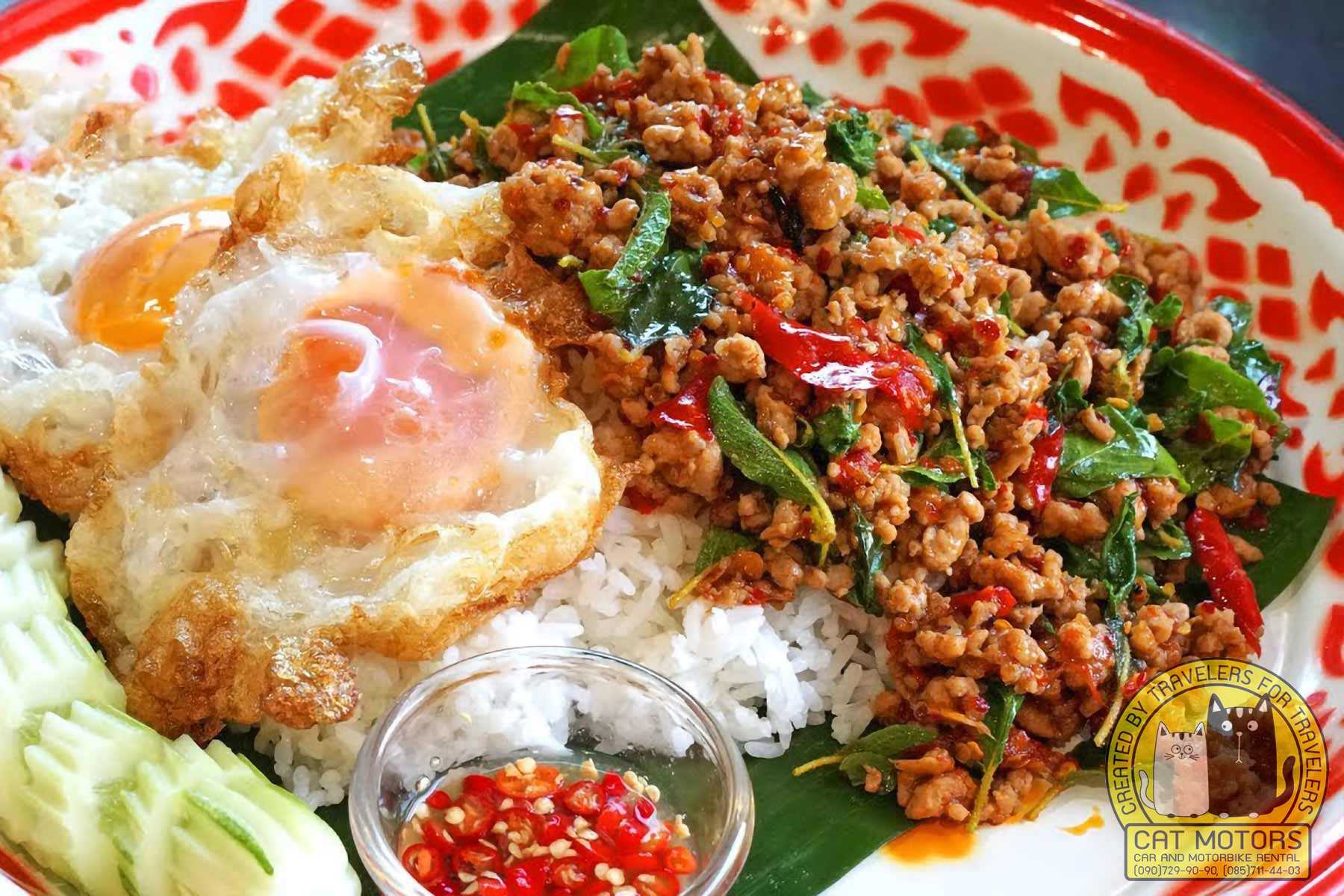
A plate of pad kaprow (rice with a crispy fried egg and spicy pork mince, photo above) will only cost you $1.
Boat trip from Mae Sam Laep to Sop Moei
The first village was founded here in 1961 by Mr. Lam Mong and Mrs. Pocha, who fled the war in Burma. Originally there were only a few houses here. But as the border trade with Thailand increased and the political and military situation in Burma during Prime Minister U‑Nu’s rule became more and more heated, people from other places also began to migrate here in search of a peaceful and tranquil life. It is now quite a large settlement, with 10 villages scattered throughout the surrounding hills and neighborhoods, with more than 9,000 people.
The river cruise takes approximately 2 hours both ways. The cost to rent a boat is 1,500 baht.
Mae Saam Laep is a community of Karen Christians who are Baptists. This is why all the inhabitants of this village go to church on Sundays, and because the church service does not end until noon, absolutely all the houses and stores here are closed on Sundays until lunchtime.
Two-color confluence of rivers
Here you will encounter a unique natural phenomenon: the two-color confluence of rivers. Here, the Moei River joins the Salween River before heading into Myanmar. The color of water is different because each of them flows through regions with varying features of soil, which creates a fantastic effect when they merge. This can be seen with the naked eye right from the sandy beach.
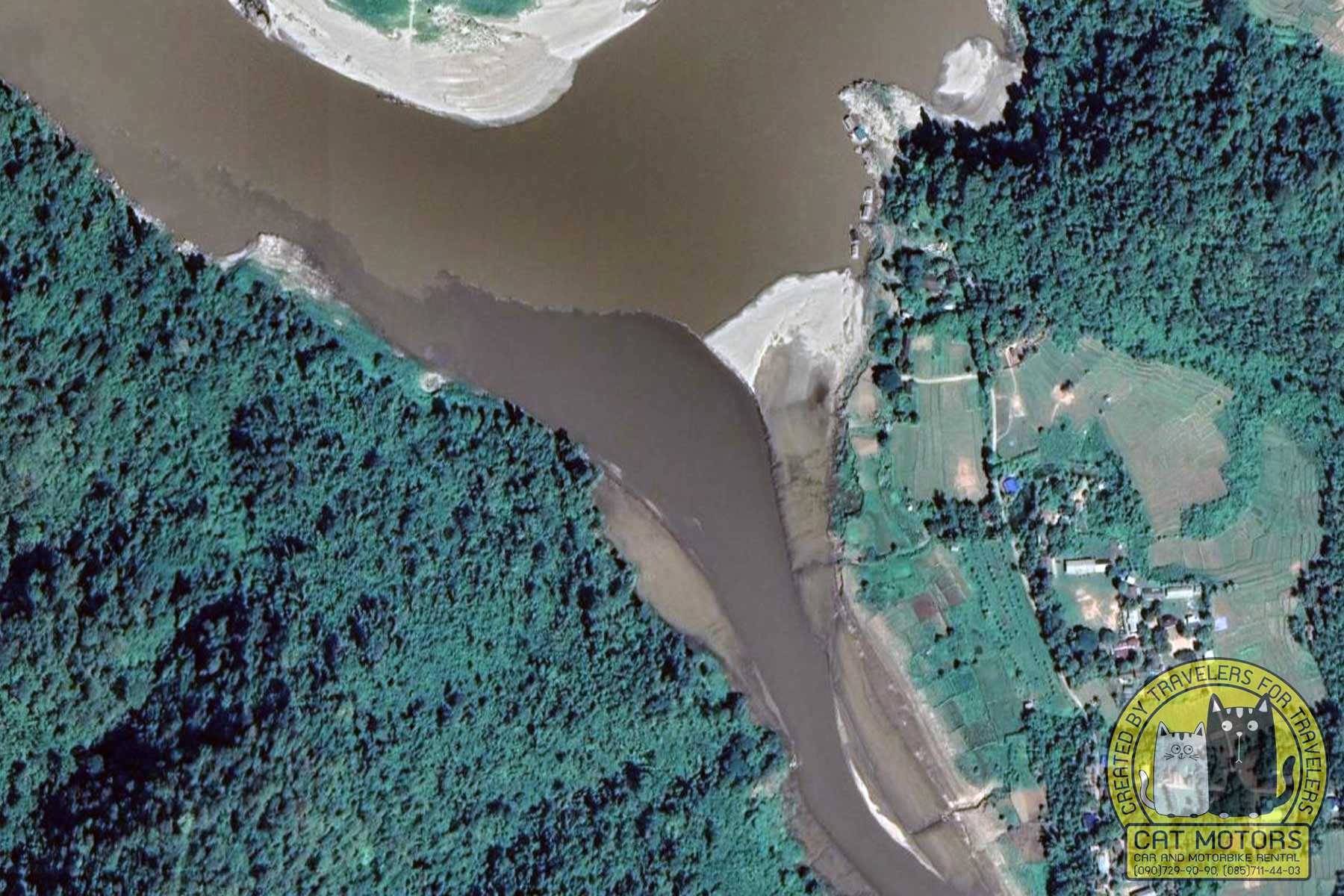
Sunset at Ban Bon Loe Camping
A place where you can see how a sea of mist covers not only Thailand but also neighboring Myanmar. Once settled at the campsite, you will find a beautiful sunset shimmering with unimaginable natural colors in the evening. At night, you can see a beautiful starry sky. In the morning, at the Misty Sea of Two Lands viewpoint, you will encounter a magnificent sea of mist that stretches to the horizon as far as the eye can see. You can rent a tent with bedding from locals for as little as 100 baht. You can also order breakfast, lunch and dinner from them.
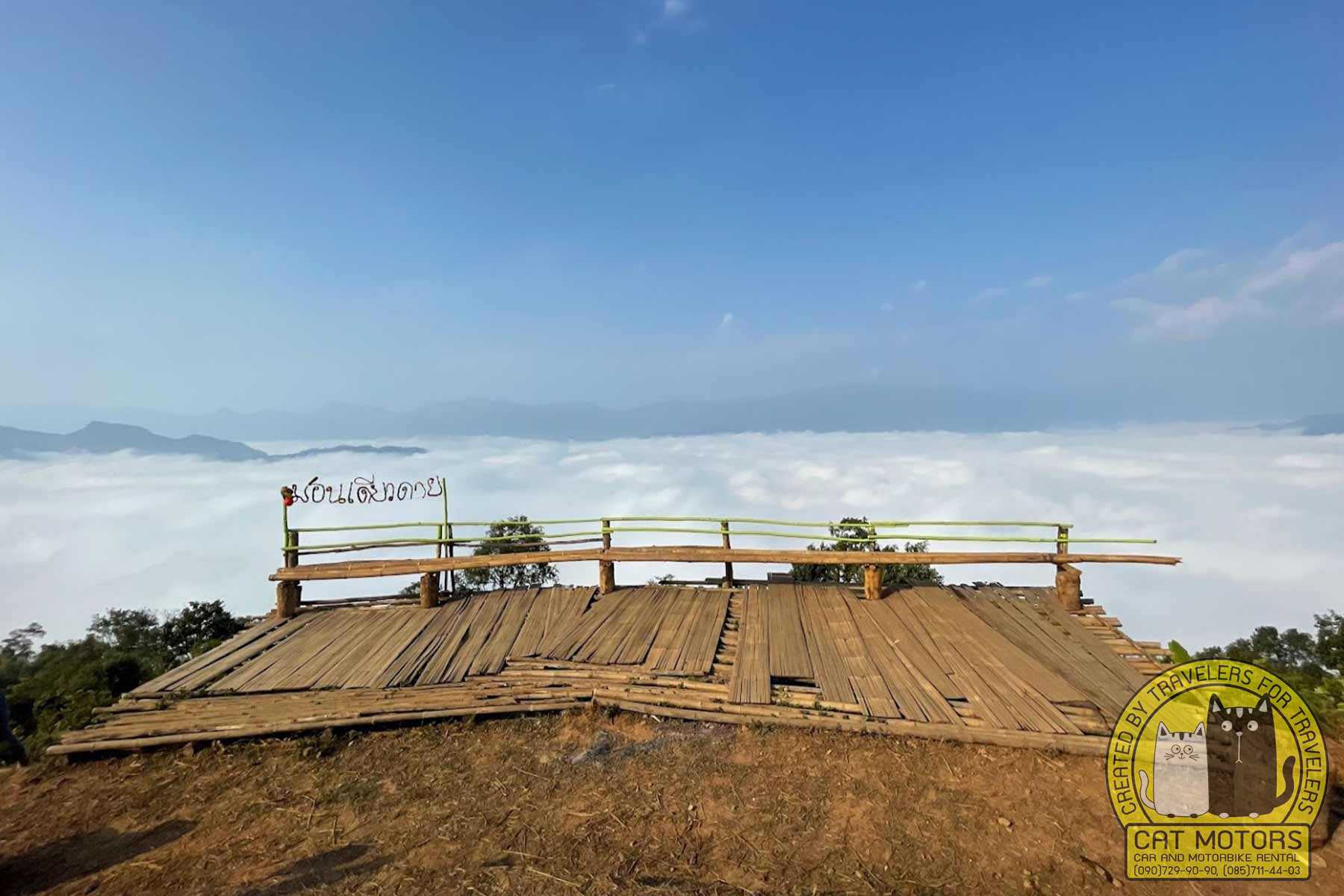
On Google Maps, look for Ban Bun Loe School (the campsite is near the school), and when you go there, download a map of the area beforehand. There is no electricity, no phone signal, no Wi‑Fi, no 5G. Forget about the benefits of civilization — you are in the real world.
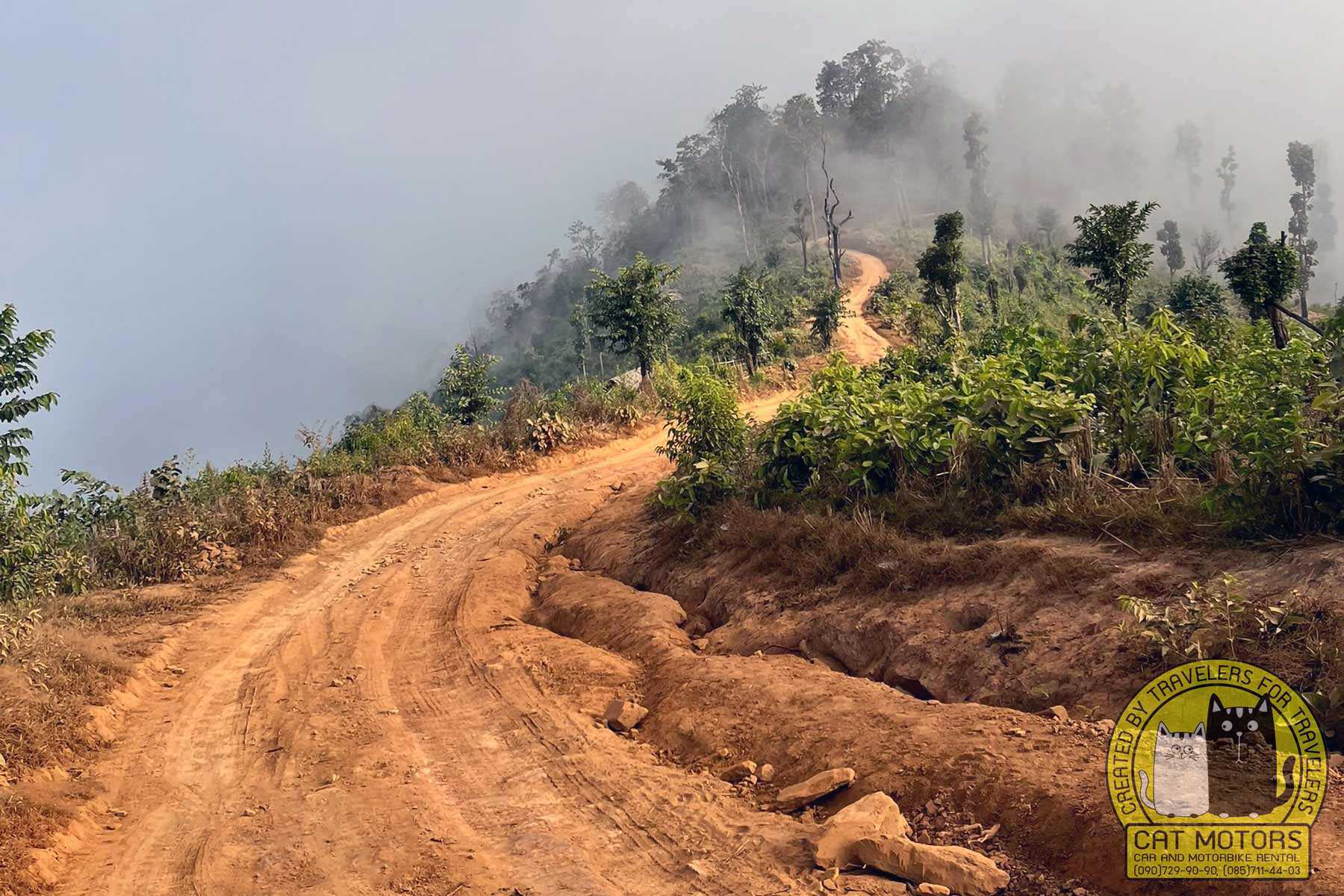
Even though it’s only 60 kilometers from Mae Sariang to this spot, the trip will take about 3 hours. For those traveling by motorbike, enduro or motorbike with a semi-auto gearbox are recommended. For those who travel by car, it is recommended to use 4×4 vehicles. It is not recommended to visit this place during the rainy season, as about a third of the way goes on a dirt road, which is impossible to drive on, even for AWD.
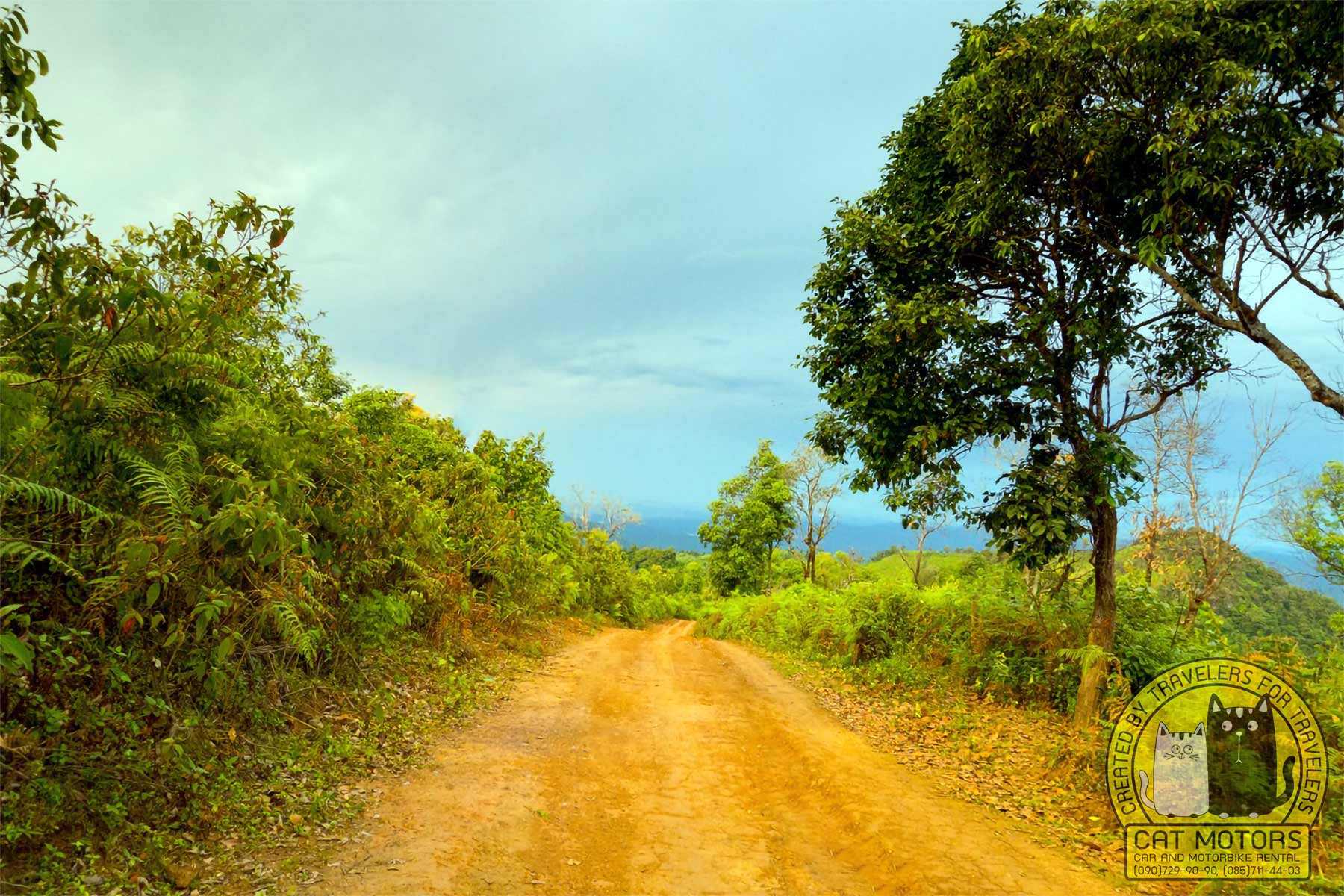
Therefore, it makes more sense to get here from Sob Moei (see above), which you will visit during a river cruise. The travel time will only take 20 minutes.
Klo Se Lo Viewpoint
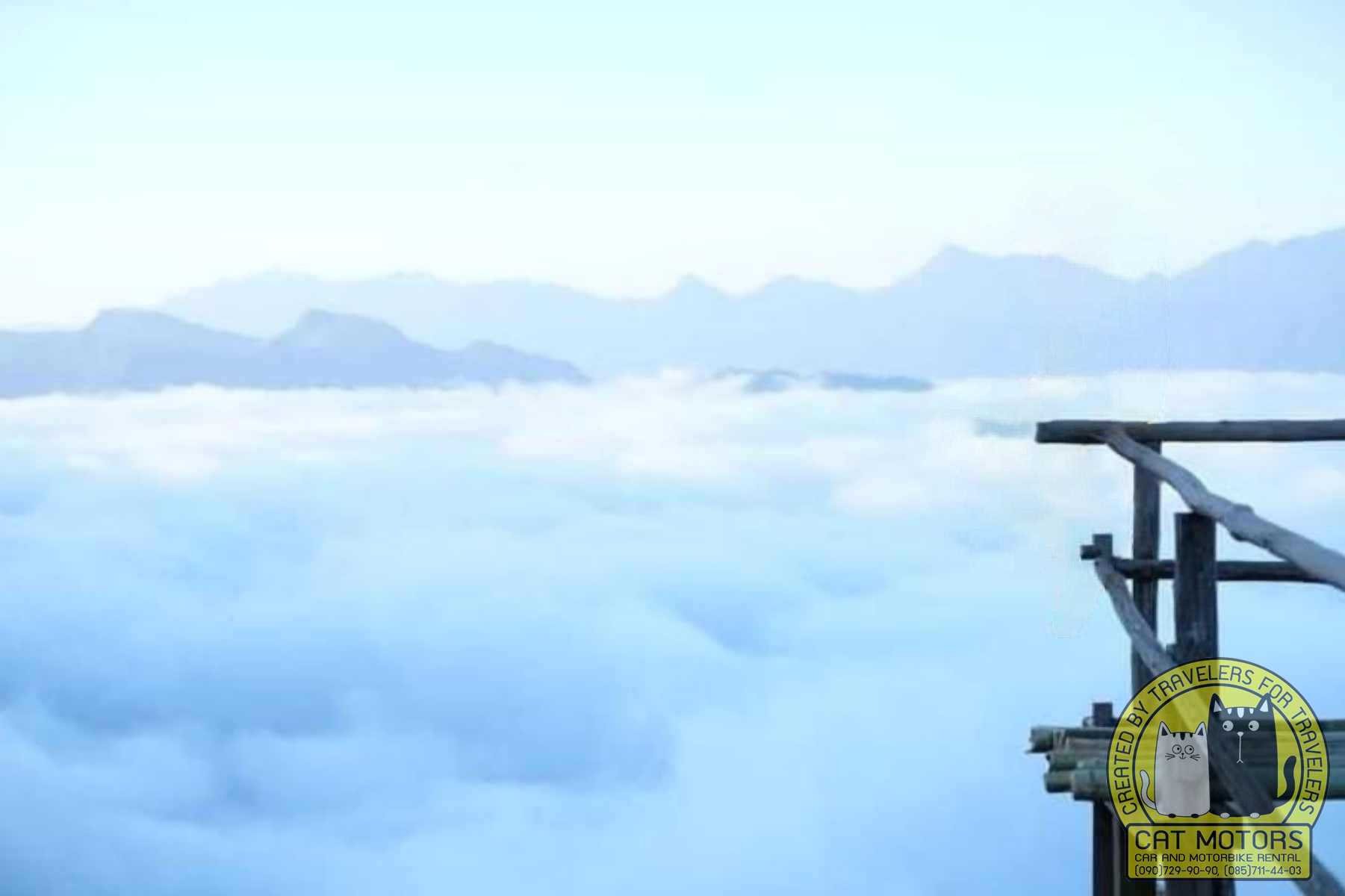
Another viewpoint and campsite nearby where you can take amazing photos. Be sure to bring warm clothes, and be sure to keep your vehicle’s tank full. Finding a gas station along the way is problematic.
Mae Sariang Weather
When planning your trip, pay attention to this weather widget. According to our observations, this informer most accurately predicts the weather in Mae Sariang.
If you’re planning to vacation in northern Thailand for a few days and haven’t yet made up your mind about what sights you want to see, then check out our online Chiang Mai attractions guide.
Quick Facts about Mae Sariang
- Geographical Location: Mae Sariang is situated in Mae Hong Son Province, Northern Thailand, near the Myanmar border.
- Population: The town has a modest population, reflecting its tranquil nature. As of recent data, the population is approximately 13,000.
- Climate: Tropical savanna climate, with distinct wet and dry seasons. The wet season runs from May to October, while the dry season spans from November to April.
- Historical Significance: Mae Sariang has a rich history intertwined with the Lawa Hill tribes and later the Shan people. The town’s history dates back several centuries and is a blend of Thai, Burmese, and hill tribe cultures.
- Cultural Diversity: It’s home to a mix of ethnic groups, including Thai Yai, Lawa, Karen, and Hmong, each contributing to the town’s diverse cultural tapestry.
- Architectural Highlights: The town is known for its traditional Shan-style temples, such as Wat Jong Sung and Wat Jong Sung Khun, showcasing intricate wood carvings and unique Shan architecture.
- Natural Attractions: Surrounded by lush mountains and the Yuam River, it’s a gateway to natural attractions like Salawin National Park, renowned for its stunning river views and trekking opportunities.
- Local Cuisine: The local food is a blend of Thai and Burmese influences, with dishes like Khao Soi (curry noodle soup) and Shan-style rice.
- Economic Base: The economy primarily revolves around agriculture, including rice and vegetable farming, and increasingly, eco-tourism.
- Festivals and Events: The town hosts various cultural festivals, such as Songkran (Thai New Year) in April and Loi Krathong in November, reflecting its rich cultural heritage.
- Accessibility: Mae Sariang is accessible by road from Chiang Mai, with the journey taking approximately 4 hours. It remains less frequented by tourists, offering a more authentic and tranquil experience.
- Accommodation Options: A range of accommodation is available, from guesthouses and boutique hotels to eco-lodges, catering to various budgets and preferences.
- Local Handicrafts: The town is known for its local handicrafts, including textiles and bamboo crafts, often sold in small, family-run shops.
- Language: While Thai is the official language, many locals also speak their ethnic languages and some English, especially in tourist areas.
- Connectivity: Mae Sariang is well-connected with mobile networks and internet services, making it convenient for travelers to stay connected. If your phone supports eSIM, we recommend that you purchase a local eSIM in advance. Especially since it is inexpensive.
Travel Tips
Best Time to Visit: The ideal time to visit Mae Sariang is between November and February. During these months, the weather is cooler and more comfortable for exploring. The rainy season from May to October can be beautiful but might restrict outdoor activities.
Getting There: Mae Sariang doesn’t have its own airport. The most common way to reach there is by road from Chiang Mai. The journey offers scenic views but be prepared for winding roads.
Cultural Etiquette: Respect local customs and traditions. Dress modestly when visiting temples, and always remove your shoes before entering. Learn a few basic Thai phrases; this effort is often appreciated by locals.
Accommodation: Choose from a variety of options, from riverside guesthouses to eco-lodges. Booking in advance isn’t always necessary except during Thai holidays or festivals, but it’s advisable during the high season.
Local Cuisine: Try local dishes that blend Thai and Burmese flavors. Street food stalls and local markets are great places to sample authentic cuisine. Don’t miss trying the local coffee, as the region is known for its coffee plantations.
Exploring the Town: Mae Sariang is small and can be easily explored on foot or by renting a bicycle. This allows for a more intimate experience of the town and its surroundings.
Visiting Temples: The town is dotted with beautiful Shan-style temples. Dress respectfully and consider visiting during off-peak hours to avoid crowds and fully appreciate the tranquil atmosphere.
Outdoor Activities: For adventure seekers, there are trekking and rafting opportunities, especially in the nearby Salawin National Park. Always go with a local guide for the best and safest experience.
Interacting with Local Communities: Engage respectfully with local ethnic communities. Always ask for permission before taking photos and consider purchasing handicrafts directly from artisans as a way to support the local economy.
Health and Safety: Carry basic first aid and any necessary medications as medical facilities are limited. Stay hydrated and protect yourself from the sun.
Connectivity: While Mae Sariang is relatively well-connected, some remote areas might have limited mobile reception. Prepare for this by downloading maps and essential information beforehand. If your phone supports eSIM, we recommend that you purchase a local eSIM in advance.
Responsible Tourism: Practice eco-friendly habits. Dispose of waste properly, use water sparingly, and be mindful of your impact on the natural and cultural environment.
Money Matters: Have enough cash as ATMs might be scarce outside the town center. Small local businesses may not accept credit cards.
Local Events and Festivals: If your visit coincides with local festivals like Songkran or Loi Krathong, participate in the celebrations for a truly unique experience.
Leaving Mae Sariang: If continuing to explore Northern Thailand, consider heading to nearby Pai or back to Chiang Mai. Local bus services and car rentals are available for onward journeys.
Pros & Cons for Travel to Mae Sariang
Traveling to Mae Sariang, a quaint town in Northern Thailand, offers a unique experience, but like any destination, it has its pros and cons. Understanding these can help travelers make informed decisions.
Pros:
- Cultural Authenticity: Mae Sariang is relatively untouched by mass tourism, offering a more authentic Thai experience with rich cultural and ethnic diversity.
- Natural Beauty: Surrounded by mountains and rivers, the town provides stunning natural landscapes, perfect for nature enthusiasts and photographers.
- Tranquility: Its off-the-beaten-path status means fewer tourists and a peaceful atmosphere, ideal for those looking to escape the hustle and bustle of more popular destinations.
- Cultural Sites: The town is home to beautiful Shan-style temples and historical sites, offering insights into the local culture and history.
- Outdoor Activities: Opportunities for trekking, river rafting, and exploring national parks like Salawin are abundant, catering to adventure seekers.
- Local Cuisine: The food in Mae Sariang is a delightful blend of Thai and Burmese influences, providing a unique culinary experience.
- Affordability: Compared to more touristy areas in Thailand, Mae Sariang is quite affordable in terms of accommodation, food, and activities.
Cons:
- Accessibility: Mae Sariang is not easily accessible; the journey from major cities like Chiang Mai can be long and tiring, especially on winding mountain roads.
- Limited Amenities: Being a small, less developed town, it lacks the amenities and luxuries that some travelers might be accustomed to in more urban areas.
- Language Barrier: English is not widely spoken, which could pose a challenge for travelers who do not speak Thai or Burmese.
- Limited Nightlife: The town has a very laid-back atmosphere with limited options for nightlife, which might not appeal to those looking for a vibrant party scene.
- Seasonal Constraints: The rainy season can limit outdoor activities and accessibility to some areas due to heavy rains and potential flooding.
- Healthcare Facilities: Limited medical facilities mean that travelers with health issues may need to travel to larger cities for treatment.
- Connectivity Issues: Internet and mobile network coverage can be spotty, particularly in more remote areas around the town. If your phone supports eSIM, we recommend that you purchase a local eSIM in advance.
YT Video Review
Martin from Fitness Travel
A short review from Martin. Of course, it does not cover all the places we have described in our guide, but this is not surprising because, as we wrote earlier, Mae Sariang is far from the tourist routes trampled by travelers.
Motogirl in Thailand aka Zed
In this video, which was filmed by Zed on the road, you will not see reviews of the sights, but you will see the state of the roads that you will have to travel on this journey.
Let It Be
Another review was recorded by the guys from the Let It Be YT channel. Despite the fact that it is voiced in Thai, the video has captions with English translation. But, again, their review does not cover everything that you will see on this route. Therefore, you have to explore the entire route on your own!
FAQ
If you are traveling to Mae Sariang on your own, in that case you can rent a motorcycle from our company in Chiang Mai. You can also hire a private minibus that will take you to Mae Sariang and back for just 5,000 baht.
Alternatively, you can buy tickets for the public bus at the Arcada bus station. Tickets are only 280 baht and travel time is about 5 hours. But this is the most inconvenient way to travel, since all the attractions are at a distance, and you can not see them without private transport.
Yes, Mae Sariang is worth visiting. It is a small town in northern Thailand that is known for its stunning natural beauty, friendly locals, and unique culture. There are plenty of activities to do in Mae Sariang, such as trekking, rafting, and exploring the local markets. It is also a great place to relax and enjoy the peaceful atmosphere.
This place is known not only for its delightful and unspoiled nature, but also for its vast teak forests. In the 19th century, the Bombay Burmah Trading Corporation, which harvested teak in Mae Sariang Province, was the largest exporter of teak wood from Siam not only to Europe but also around the world. Also, Mae Sariang is known for its stunning natural beauty, friendly locals, and unique culture. Additionally, Mae Sariang is known for its peaceful atmosphere and its traditional food.
If you have free time, be sure to visit Kaew Komol Cave (ถ้ำแก้วโกมล), located 32 km from the town.
Calcite crystal caverns are a rare phenomenon in nature. There are only three known caves in the world, located in Australia, China, and Thailand. Inside you will find several rooms. The further you go deeper, the more beautiful space you will find. No more than 15-20 people can be in the cave per visit. If you plan to visit this place, don’t forget to take a flashlight. But it would be much better if you hire a guide on site who will not only help you with lighting the trail but will also make sure you don’t faint because the cave has a high concentration of carbon dioxide, which makes calcite crystals form.
We highly recommend you to visit Mitmaitri Coffee, where you will find affordable drinks and pastries that you can eat sitting on the balcony with a fantastic view of the river and the forest. This place is highly recommended not only because you can have a delicious snack here but also because you will be able to watch the stunning panoramic views of the surrounding scenery while having a snack.
For lovers of grilled meat, we recommend visiting Mae Luang Pen Café. Here you will find traditional northern Thai spicy sausage cooked according to authentic local recipes, pork and chicken kebabs, and other dishes cooked on hot coals.
And, of course, be sure to try the local Khao Soi, which has its unique flavor thanks to Burmese culinary traditions’ influence on the region’s dishes, at Pa Daeng Khao Soi. This spicy soup, made with chicken or beef, which is a specialty of Northern Thailand, if you don’t know, is recognized as the most delicious soup in the world.
You can easily spend a few days in Mae Sariang, depending on what activities you plan to do. If you plan to explore the local markets, go trekking, and rafting, then you should plan to stay for at least three days. If you just want to relax and enjoy the peaceful atmosphere, then two days should be enough.
You should avoid visiting Mae Sariang during the rainy season, which runs from May to October. During this time, the weather is hot and humid, and the roads can be difficult to drive due to flooding. Additionally, some of the outdoor activities may be closed due to the weather.
The coldest month in Mae Sariang is January, when temperatures can drop to as low as 10°C (50°F). This is the best time to visit if you want to experience the cooler weather and enjoy the outdoor activities.
The best time to visit Mae Sariang is between November and February, when the weather is cooler and the skies are clear. This is also the peak season for tourism, so you can expect to find plenty of activities and attractions to explore.
Dive into the heart of Northern Thailand with our expertly crafted travel guides. They highlight the best routes and hidden gems of the region. For those eager to begin, our best scooter rentals in Chiang Mai offers great options. Before you hit the road, please take a moment to read through our terms and conditions. With this knowledge, you’ll be well-equipped to explore the lush scenery and cultural spots that make this area so special. From the mountains to the markets, experience all the wonders Northern Thailand has to offer.
Additionally, make sure to visit our tips and advice sections, where you’ll find essential recommendations for safe and enjoyable riding. Our website is packed with valuable information to help you make the most of your motorbike adventure. By utilizing these resources, you can ensure a well-planned, memorable trip that captures the true essence of Northern Thailand’s natural and cultural treasures.
Cat Motors Team
- Author: Konstantin Zh
- Updated: 16/09/2025
- No Comments




